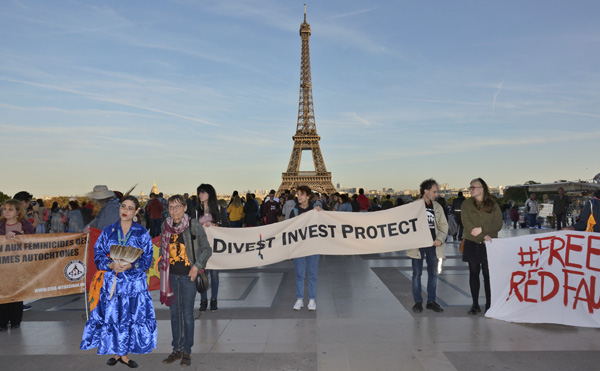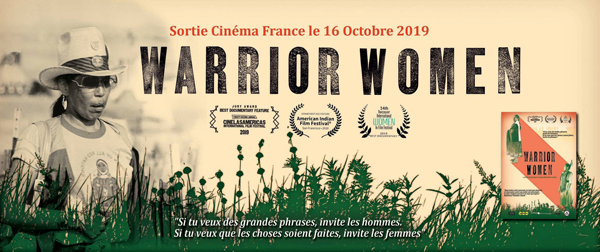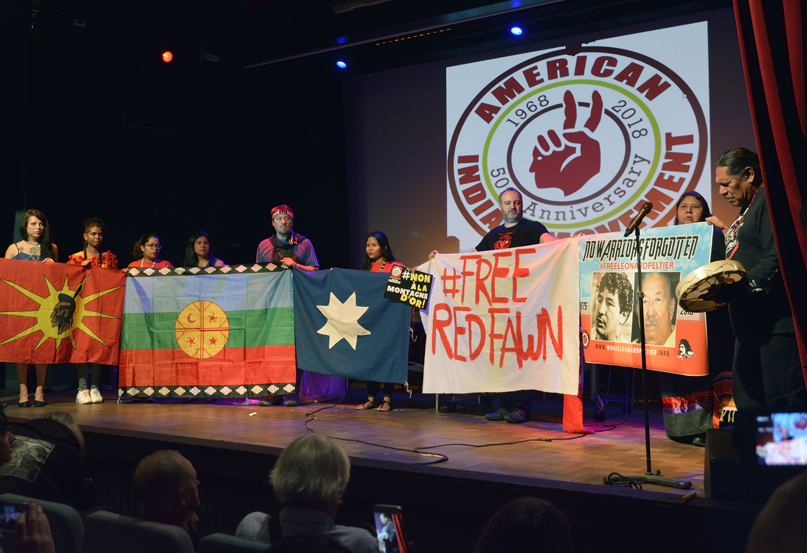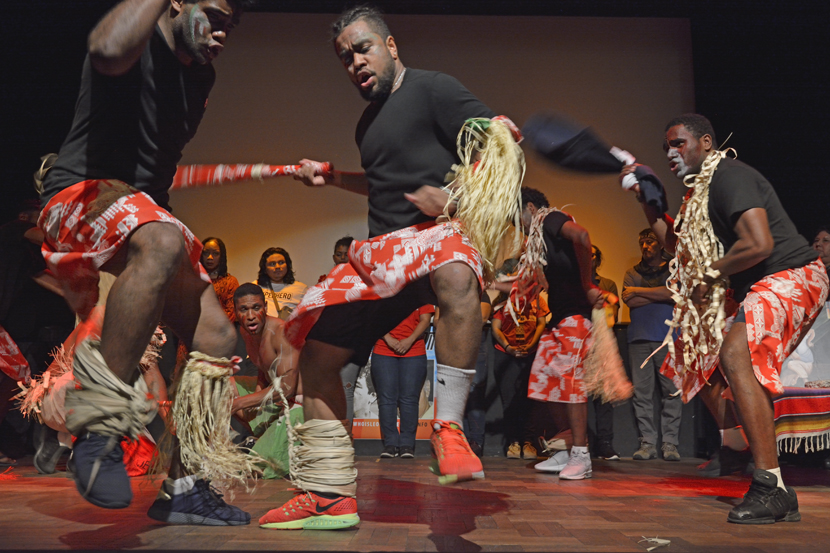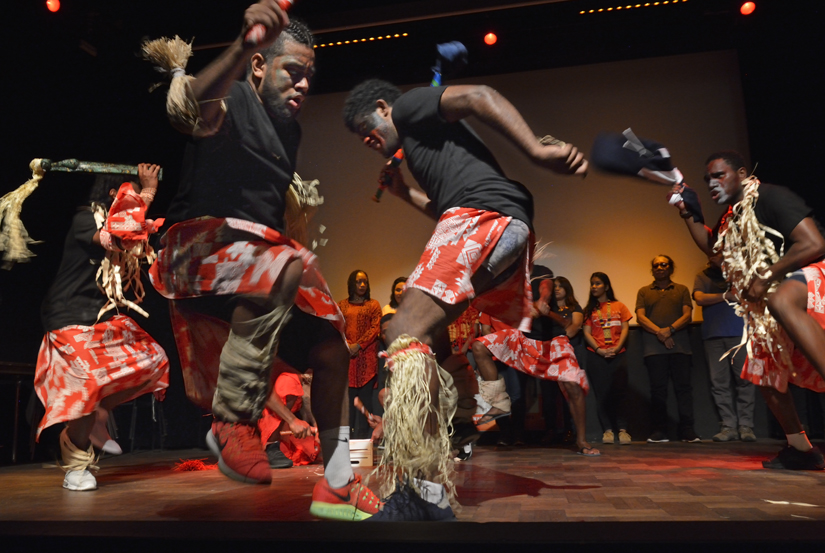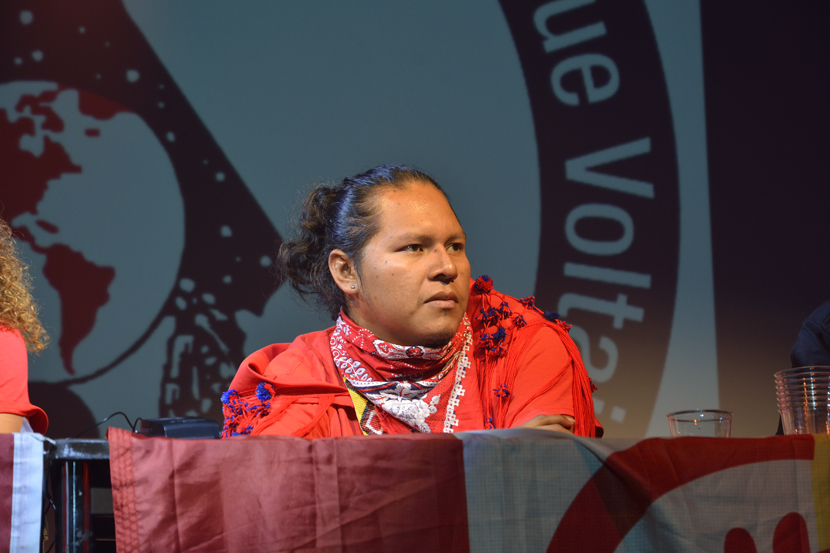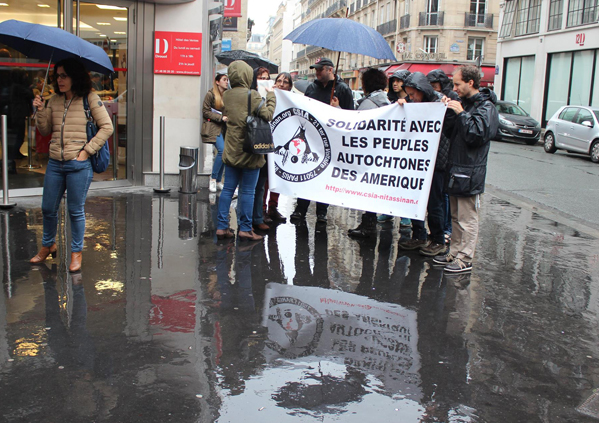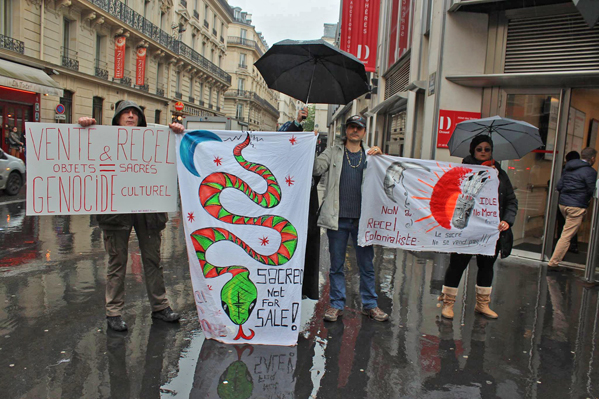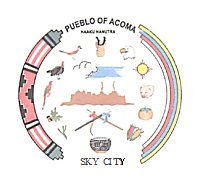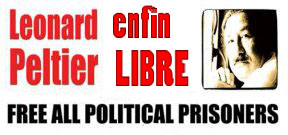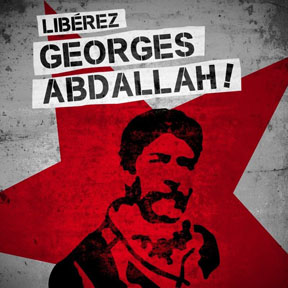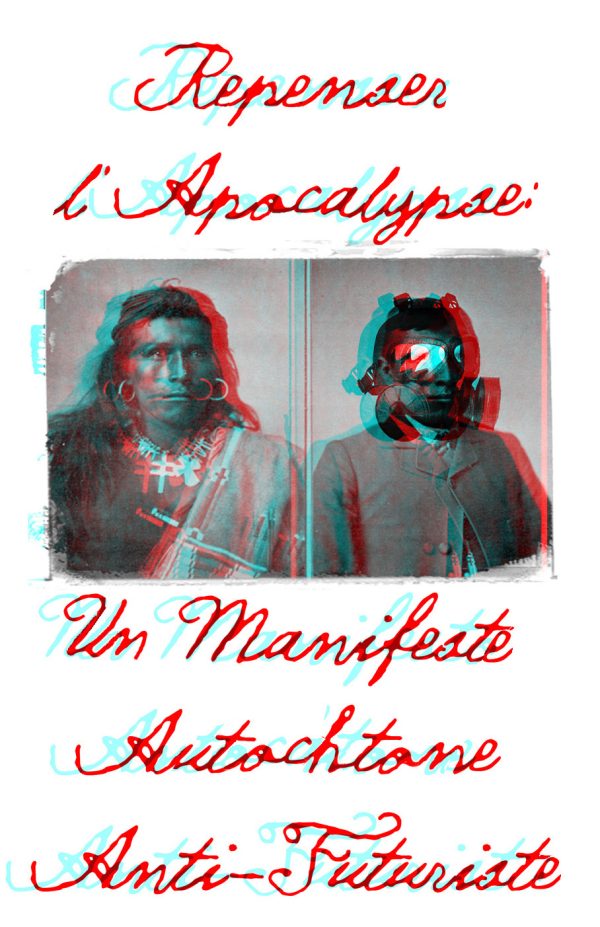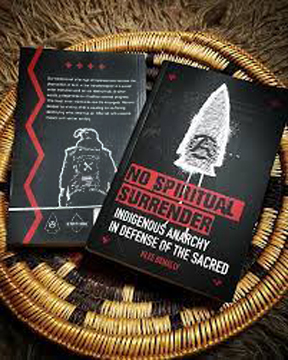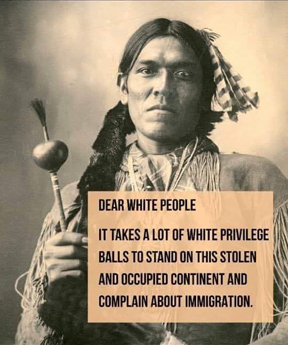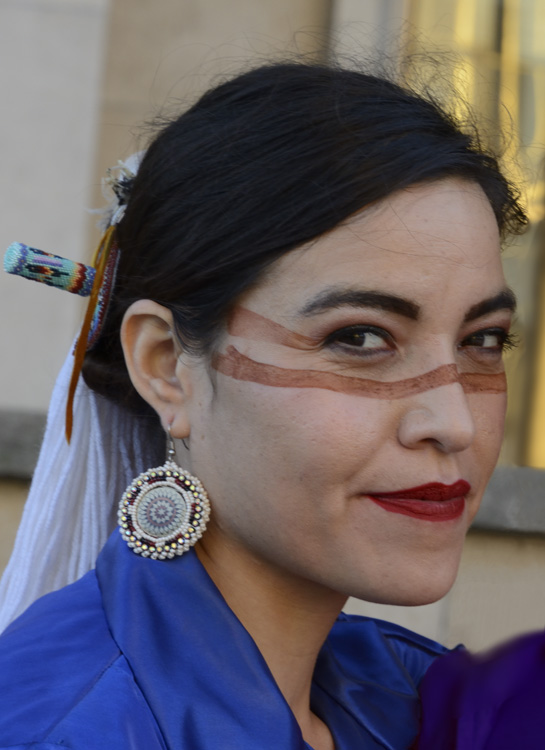 Michelle Cook, a Diné attorney, was one of the guests of the Annual Solidarity Day of the CSIA-Nitassinan, on October 12th, 2019. She is now preparing a Ph.D. in political sciences at Arizona University, on the, in the USA not separable issues of Indigenous Human Rights, disinvestment and gender. She is founder of the Water Protectors Legal Collective (for those who tried to stop the DAPL in Standing Rock, from February 2016 to April 2017). She is a member of Women Earth and Climate Action Network (WECAN). She has been touring Europe for a campaign (Divest Invest Protect) that aims to put pressure on banks and insurance companies to remove their funds from racist projects, deadly to environment and peoples depending on it.
Michelle Cook, a Diné attorney, was one of the guests of the Annual Solidarity Day of the CSIA-Nitassinan, on October 12th, 2019. She is now preparing a Ph.D. in political sciences at Arizona University, on the, in the USA not separable issues of Indigenous Human Rights, disinvestment and gender. She is founder of the Water Protectors Legal Collective (for those who tried to stop the DAPL in Standing Rock, from February 2016 to April 2017). She is a member of Women Earth and Climate Action Network (WECAN). She has been touring Europe for a campaign (Divest Invest Protect) that aims to put pressure on banks and insurance companies to remove their funds from racist projects, deadly to environment and peoples depending on it.
Michelle Cook en français
Also on Censored News
October 12th, 2019
Transcription and photos Christine Prat
 I think in terms of Divest, Invest, Protect, I don’t consider myself so much a lobbyist as a reality check, and someone who is merely delivering facts and truths. And ultimately, I think that one of the important things we are doing is that we are not there to ask these banks to pity us, we are giving them a very clear warning that their time of dominating this earth is coming to an end.
I think in terms of Divest, Invest, Protect, I don’t consider myself so much a lobbyist as a reality check, and someone who is merely delivering facts and truths. And ultimately, I think that one of the important things we are doing is that we are not there to ask these banks to pity us, we are giving them a very clear warning that their time of dominating this earth is coming to an end.
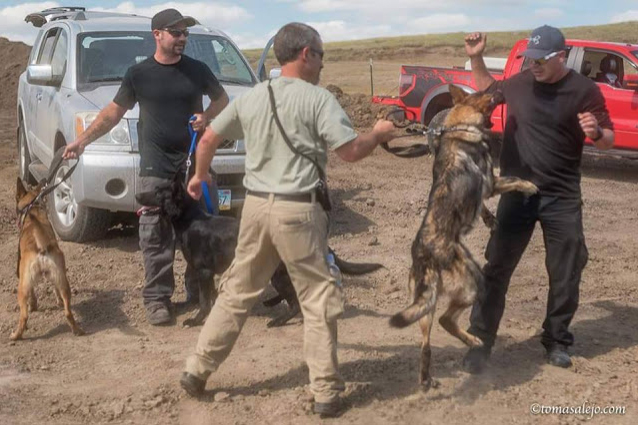 After the Dakota Access Pipeline, which was a pipeline that over 10,000 people fought, in the heartlands of the United States of America, we were able to achieve, within the Obama administration, a halt to the pipeline. Yet, when the Trump administration came to power, within days that easement was denied and the pipeline was allowed to go through and under the Missouri River. Before that, since August 20, 2016, I had to watch our people being abused. I watched and had to witness and document the dog attacks, the bite marks on the breasts of my peers, on the breasts of the women. I had to sleep wondering whether or not my friends would be murdered. We had to watch as two of our precious Diné tribal members were injured. Their eyes were blinded through the use of so called non-lethal weapons by the police forces.
After the Dakota Access Pipeline, which was a pipeline that over 10,000 people fought, in the heartlands of the United States of America, we were able to achieve, within the Obama administration, a halt to the pipeline. Yet, when the Trump administration came to power, within days that easement was denied and the pipeline was allowed to go through and under the Missouri River. Before that, since August 20, 2016, I had to watch our people being abused. I watched and had to witness and document the dog attacks, the bite marks on the breasts of my peers, on the breasts of the women. I had to sleep wondering whether or not my friends would be murdered. We had to watch as two of our precious Diné tribal members were injured. Their eyes were blinded through the use of so called non-lethal weapons by the police forces.
So, when the pipeline was going through, after the Trump administration took office, for me, for my own healing and my own wellness, I needed to know who paid for this. I had to see them, it was important. I needed to go where they thought they were safe. And they had to see me, so that whatever tears and whatever pains I had to carry was no longer mine, that all that violence and all that trauma that was given to us by their finance, they were going to take it back to them. So, when we visit these banks, I leave that pain with them, I leave that suffering, I leave that trauma within the walls of their institutions. I think that, on a very basic level, what we are doing is trying to change financial laws, but I think on a much deeper level, what we are doing is really an exorcism of the system, of the spirit of predation, that has existed on this planet, that has disconnected us from who we are, that has alienated us from our inheritance as sacred creatures, sacred children of this earth.
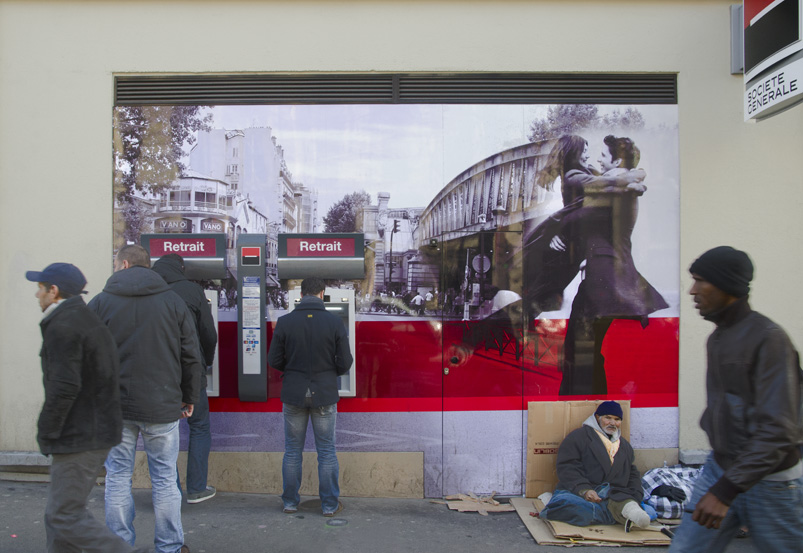 So, I learned a lot from these meetings. From that particular A.G.M., this Annual General shareholders Meeting. As we approached the building, I could see the snipers on the roof. And here we are, Indian women. What have we done? Why do we need a sniper on our head? What more did we have than my feathers and pollen, and the medicine? So, I went to that meeting with those guns on us, and so did those women. And we were watched and we were followed by maybe security officers. Every time I went to the bathroom I was followed, every move I made, I was watched, in that space. Because we had entered into the temple of their god. Because money is the god of the colonialists. It has taken the place of the sacred. So, instead of chants you hear corporate songs, instead of seeing the sacred symbols of life you see their corporate image. This is a reverse prayer. When I was in that meeting I felt – a lot of people see that and say “Oh, you must be so brave”, but we are only brave because we have to be, only brave because of necessity, we have to, I have to. And, even though I had these men with guns following me, I had to meditate in there, and say to myself “I am going to do this, I can do this.” I think everyone has moments where you are going to be confronted with something that you feel that you can’t do. But you have to work through those fears, to be able to take the steps that are going to be necessary to save this planet. So, I was the last person to speak at the A.G.M. and as soon as my first colleague was on the stage, the
So, I learned a lot from these meetings. From that particular A.G.M., this Annual General shareholders Meeting. As we approached the building, I could see the snipers on the roof. And here we are, Indian women. What have we done? Why do we need a sniper on our head? What more did we have than my feathers and pollen, and the medicine? So, I went to that meeting with those guns on us, and so did those women. And we were watched and we were followed by maybe security officers. Every time I went to the bathroom I was followed, every move I made, I was watched, in that space. Because we had entered into the temple of their god. Because money is the god of the colonialists. It has taken the place of the sacred. So, instead of chants you hear corporate songs, instead of seeing the sacred symbols of life you see their corporate image. This is a reverse prayer. When I was in that meeting I felt – a lot of people see that and say “Oh, you must be so brave”, but we are only brave because we have to be, only brave because of necessity, we have to, I have to. And, even though I had these men with guns following me, I had to meditate in there, and say to myself “I am going to do this, I can do this.” I think everyone has moments where you are going to be confronted with something that you feel that you can’t do. But you have to work through those fears, to be able to take the steps that are going to be necessary to save this planet. So, I was the last person to speak at the A.G.M. and as soon as my first colleague was on the stage, the  audience was hissing at us, yelling and hissing at us. Immediately, as we entered the stage, despite of the fact that there were more shareholders there who were speaking, as soon as we got on the stage, we felt all this wave of malice and hostility. And the meditation that was required, in the face of that adversity, was very difficult. Because the point is, they are to knock you off so that you can’t communicate the truth. But I understood what was happening and through that meditation, through that prayer, I was able to maintain that calm center and to give them a message to hiss about. So, I think the process of taking women into those institutions is on its own an act of exorcism, because I think the very presence of Indigenous women is an act of purification of these temples of this so-called Western Civilization.
audience was hissing at us, yelling and hissing at us. Immediately, as we entered the stage, despite of the fact that there were more shareholders there who were speaking, as soon as we got on the stage, we felt all this wave of malice and hostility. And the meditation that was required, in the face of that adversity, was very difficult. Because the point is, they are to knock you off so that you can’t communicate the truth. But I understood what was happening and through that meditation, through that prayer, I was able to maintain that calm center and to give them a message to hiss about. So, I think the process of taking women into those institutions is on its own an act of exorcism, because I think the very presence of Indigenous women is an act of purification of these temples of this so-called Western Civilization.
What I think is unique about the campaign and the message we carry as Indigenous women within this divestment movement, is that it’s not just about taking money from that bad bank and placing it somewhere else. Centrally, what we are asking is for individuals to question the construction and the abstraction of money itself. We really need to understand the creation story of the banks of Europe in order to understand and to revive, to restore the ancient economic traditions of Indigenous Peoples that can be alternatives and that can heal this climate genocide that we are currently faced with. I think it’s also asking people: “Ask yourself what are your values, what have you been told as your value? Is your value just based on what you earn? Is your value based on your gender? Is your value based on your race? Are you good enough, are we ever good enough? Are we ever whole? Are we ever full?” We are never full in this capitalist system, there is never enough and is that value? What is your value? For us, as Indigenous people, we are taught even before we are born. When the baby is still in the womb, it receives songs, inside, in-utero, it is already encoded with the ancient knowledge of who you are. That is how it works, because when you are removed from your true identity as a sacred being of this universe, you don’t understand your power, and you don’t understand that you are never alone, that you are always connected, that you are always surrounded by your ancestors and by Creation, the elements are your relatives.
And this has been the civilizing mission of the so-called Western Civilization since the cult of Rome began. And it was those papal bulls issued by Pope Alexander Borgia that issued the Doctrine of Discovery that allowed the “Manifest Destiny” theory, to allow the colonization of the entire world, but also here against the tribes of Europe. You just happen to be closer to the seat of the empire, centuries ago. We just happen to be farther away, so we remember the time before the cult of Rome came. But that knowledge and your connections have been removed violently from you, by the Inquisition. That history of colonization, of imperialism, and inherently that racism and that feminicide, is all part of the intersectional forces that are bringing us to that problem that we have now with climate genocide.
So, as Indigenous Peoples we are the guardians of that knowledge of the time before, and that is why it is so important to listen to Indigenous Peoples and to follow their leadership. Because, in order for us to survive, we have to realign, in order for us to survive, you have to heal yourself. We are coming up to the 400th anniversary of the first ships coming to our shores, and now Indigenous Peoples are coming back here, so we see this full circle coming, and I see our presence here as what I hope will be a real awakening for the people of Europe. To re-awaken and to rekindle that sacred spirit that is inside us all, so that we can heal and bring together back what has been broken.
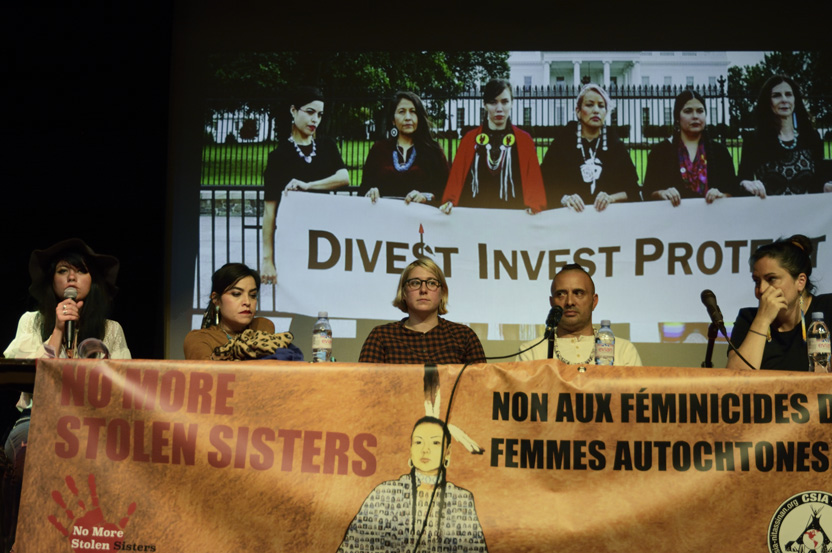 So, I invite you to join us and to really understand that I am not different from you, that we are one, that we are one people. We should not be divided and we have to unite, we have to come together now, there is no more time. I invite you to join and give yourself permission to follow your higher purpose and to find what you can contribute and what you can do to participate in the healing of this earth and to heal what has been wounded through colonization. In terms of the bank work, that kind of the simple part, that is just asking to follow Human Rights. But in order to really shift and transform society, we have to shift and transform you. So, what is it you need, what is it you want to hear, because you are here listening to us, you are all here, why are you here, what is it that you need to hear from us? I want you to ask for that from yourself: to wake up in the morning at dawn – this is what we do and this is maybe a knowledge I give you so that you can reconnect. So, in the morning wake up very early, when the sun is beginning to come up. Be disciplined. Wake up and give what you have, if it’s tobacco or if it’s corn pollen or if it’s corn meal. Offer that to the Earth. And ask for your healing, ask for the Creator to give you the strength and the knowledge. It is through this reciprocity, through this spiritual currency that you can realign and find what true power is. And that is your true inheritance as a sacred child of this universe.
So, I invite you to join us and to really understand that I am not different from you, that we are one, that we are one people. We should not be divided and we have to unite, we have to come together now, there is no more time. I invite you to join and give yourself permission to follow your higher purpose and to find what you can contribute and what you can do to participate in the healing of this earth and to heal what has been wounded through colonization. In terms of the bank work, that kind of the simple part, that is just asking to follow Human Rights. But in order to really shift and transform society, we have to shift and transform you. So, what is it you need, what is it you want to hear, because you are here listening to us, you are all here, why are you here, what is it that you need to hear from us? I want you to ask for that from yourself: to wake up in the morning at dawn – this is what we do and this is maybe a knowledge I give you so that you can reconnect. So, in the morning wake up very early, when the sun is beginning to come up. Be disciplined. Wake up and give what you have, if it’s tobacco or if it’s corn pollen or if it’s corn meal. Offer that to the Earth. And ask for your healing, ask for the Creator to give you the strength and the knowledge. It is through this reciprocity, through this spiritual currency that you can realign and find what true power is. And that is your true inheritance as a sacred child of this universe.
 Michelle Cook, avocate Diné [Navajo], était invitée à la Journée Annuelle de Solidarité du CSIA-Nitassinan 2019. Elle a fondé le « Collectif Légal des Protecteurs de l’Eau » pour aider ceux qui avaient tenté d’empêcher la construction de l’oléoduc DAPL, à Standing Rock, de février 2016 à avril 2017. Elle prépare actuellement un doctorat en Sciences Politiques à l’université d’Arizona, sur les questions, indissolublement liées aux Etats-Unis, de Droits Humains Autochtones, de désinvestissement de projets nuisibles et de sexisme. Elle est membre du WECAN (Women Earth and Climate Action Network – Réseau d’Action des Femmes pour la Terre et le Climat) et a effectué une tournée en Europe pour la Campagne intitulée « Divest, Invest, Protect », visant à faire pression sur les banques et les compagnies d’assurance européennes qui investissent dans des projets racistes. Le 12 octobre, au cours de la Journée Annuelle de Solidarité, elle s’est exprimée comme suit.
Michelle Cook, avocate Diné [Navajo], était invitée à la Journée Annuelle de Solidarité du CSIA-Nitassinan 2019. Elle a fondé le « Collectif Légal des Protecteurs de l’Eau » pour aider ceux qui avaient tenté d’empêcher la construction de l’oléoduc DAPL, à Standing Rock, de février 2016 à avril 2017. Elle prépare actuellement un doctorat en Sciences Politiques à l’université d’Arizona, sur les questions, indissolublement liées aux Etats-Unis, de Droits Humains Autochtones, de désinvestissement de projets nuisibles et de sexisme. Elle est membre du WECAN (Women Earth and Climate Action Network – Réseau d’Action des Femmes pour la Terre et le Climat) et a effectué une tournée en Europe pour la Campagne intitulée « Divest, Invest, Protect », visant à faire pression sur les banques et les compagnies d’assurance européennes qui investissent dans des projets racistes. Le 12 octobre, au cours de la Journée Annuelle de Solidarité, elle s’est exprimée comme suit.
Michelle Cook in English
12 octobre 2019
Also in English on Censored News
Traduction et photos Christine Prat
 « Je pense qu’en termes de campagne de désinvestissement, je ne me considère pas tant comme une lobbyste, que comme un agent de contrôle de la réalité, et quelqu’un qui ne fait qu’exprimer des faits et des vérités. En fin de compte, je pense qu’une chose importante, dans ce que nous faisons, est que nous ne demandons pas à ces banques d’avoir pitié de nous, mais que nous leur donnions un clair avertissement de ce que leur temps de domination de cette Terre touche à son terme.
« Je pense qu’en termes de campagne de désinvestissement, je ne me considère pas tant comme une lobbyste, que comme un agent de contrôle de la réalité, et quelqu’un qui ne fait qu’exprimer des faits et des vérités. En fin de compte, je pense qu’une chose importante, dans ce que nous faisons, est que nous ne demandons pas à ces banques d’avoir pitié de nous, mais que nous leur donnions un clair avertissement de ce que leur temps de domination de cette Terre touche à son terme.
 « Après l’affaire du Dakota Access Pipeline, un oléoduc combattu par plus de 10 000 personnes, au cœur même des Etats-Unis d’Amérique, nous avions pu obtenir, sous le gouvernement Obama, que la construction de l’oléoduc soit interrompue. Cependant, lorsque le gouvernement Trump est arrivé au pouvoir, en quelques jours cette décision a été niée, et le projet d’oléoduc a été autorisé à continuer, et à passer sous le Fleuve Missouri. Avant cela, à partir du 20 août 2016, j’avais dû voir comment les gens de notre peuple étaient maltraités. J’ai vu, j’ai été témoin, et j’ai fait des rapports sur les attaques de chiens, les traces de morsures sur la poitrine de mes semblables, sur la poitrine des femmes. J’ai dû dormir en me demandant si mais amis ne seraient pas assassinés. Nous avons dû voir deux de nos précieux membres de tribus Diné gravement blessés. Ils ont perdu des yeux à cause de l’utilisation par la police d’armes soi-disant ‘non-léthales’.
« Après l’affaire du Dakota Access Pipeline, un oléoduc combattu par plus de 10 000 personnes, au cœur même des Etats-Unis d’Amérique, nous avions pu obtenir, sous le gouvernement Obama, que la construction de l’oléoduc soit interrompue. Cependant, lorsque le gouvernement Trump est arrivé au pouvoir, en quelques jours cette décision a été niée, et le projet d’oléoduc a été autorisé à continuer, et à passer sous le Fleuve Missouri. Avant cela, à partir du 20 août 2016, j’avais dû voir comment les gens de notre peuple étaient maltraités. J’ai vu, j’ai été témoin, et j’ai fait des rapports sur les attaques de chiens, les traces de morsures sur la poitrine de mes semblables, sur la poitrine des femmes. J’ai dû dormir en me demandant si mais amis ne seraient pas assassinés. Nous avons dû voir deux de nos précieux membres de tribus Diné gravement blessés. Ils ont perdu des yeux à cause de l’utilisation par la police d’armes soi-disant ‘non-léthales’.
« Ainsi, lorsque l’oléoduc a été autorisé, après que le gouvernement Trump entre en fonction, pour moi, pour ma propre guérison et mon propre bien-être, j’ai eu besoin de savoir qui payait pour cela. Il fallait que je les voie, c’était important. Il fallait que j’aille là où ils se croyaient en sécurité. Et il fallait qu’ils me voient, afin que toutes les larmes et toute la souffrance que je devais porter ne soient plus les miennes, et qu’ils reprennent pour eux toute la violence et tous les traumatismes qui nous ont été causés par leurs finances. Alors, quand nous sommes allées dans ces banques, j’ai laissé toute cette souffrance avec eux, j’ai laissé les traumatismes dans les murs de leurs institutions. Je pense que si, à la base, ce que nous faisons est d’essayer de changer les lois de finance, à un niveau beaucoup plus profond, ce qui nous faisons est en fait un exorcisme du système, de l’esprit de prédation, qui existe depuis longtemps sur cette planète et nous a déconnecté de qui nous sommes, nous a aliéné de notre héritage en tant que créatures sacrées, d’enfants sacrés de cette terre.
 « Ainsi, j’ai appris beaucoup de ces réunions. En particulier d’une Assemblée Générale Annuelle des actionnaires. Quand nous nous sommes approchées de l’immeuble, je pouvais voir des snipers sur le toit. Et nous étions là, des femmes Indiennes. Qu’avions nous fait ? Pourquoi fallait-t-il un sniper au-dessus de nos têtes ? Qu’avions-nous de plus que mes plumes, du pollen et des herbes médicinales ? Donc, je suis allée à cette réunion avec ces fusils pointés sur nous, et c’est ce qu’ont fait aussi les autres femmes. Et nous étions surveillées et suivies, probablement par des agents de la sécurité. Chaque fois que j’allais aux toilettes, j’étais suivie, chaque geste que je faisais été surveillé. Parce que nous étions entrées dans le temple de leur dieu. Parce que l’argent est le dieu des colonialistes. Il a remplacé le sacré. Alors, au lieu d’incantations on entend leurs chansons affairistes, au lieu de voir les symboles sacrés de la vie, on voit leur image affairiste. C’est une prière renversée. Quand je me suis trouvée dans cette réunion, j’ai ressenti … Beaucoup de gens qui nous ont vu disent ‘Oh, vous devez être si courageuses !’, mais nous ne sommes courageuses que parce que nous devons l’être, courageuses par nécessité, il le faut, il faut que je le sois. Et, malgré ces hommes armés qui me suivaient, j’ai dû méditer et me dire ‘je vais le faire, je peux le faire.’ Je pense que tout le monde a de ces moments où on va être confronté à quelque chose qu’on pense ne pas pouvoir faire. Mais il faut s’efforcer de surmonter ces peurs, afin d’être capable de faire ce qui va être nécessaire pour sauver cette planète. J’étais la dernière à prendre la parole à cette Assemblée Générale des actionnaires, mais dès que ma première collègue fut sur scène, le public s’est mis à nous siffler, à hurler et à nous huer. Immédiatement, lorsque nous sommes montées sur scène, bien qu’il y eût encore des actionnaires qui parlaient,
« Ainsi, j’ai appris beaucoup de ces réunions. En particulier d’une Assemblée Générale Annuelle des actionnaires. Quand nous nous sommes approchées de l’immeuble, je pouvais voir des snipers sur le toit. Et nous étions là, des femmes Indiennes. Qu’avions nous fait ? Pourquoi fallait-t-il un sniper au-dessus de nos têtes ? Qu’avions-nous de plus que mes plumes, du pollen et des herbes médicinales ? Donc, je suis allée à cette réunion avec ces fusils pointés sur nous, et c’est ce qu’ont fait aussi les autres femmes. Et nous étions surveillées et suivies, probablement par des agents de la sécurité. Chaque fois que j’allais aux toilettes, j’étais suivie, chaque geste que je faisais été surveillé. Parce que nous étions entrées dans le temple de leur dieu. Parce que l’argent est le dieu des colonialistes. Il a remplacé le sacré. Alors, au lieu d’incantations on entend leurs chansons affairistes, au lieu de voir les symboles sacrés de la vie, on voit leur image affairiste. C’est une prière renversée. Quand je me suis trouvée dans cette réunion, j’ai ressenti … Beaucoup de gens qui nous ont vu disent ‘Oh, vous devez être si courageuses !’, mais nous ne sommes courageuses que parce que nous devons l’être, courageuses par nécessité, il le faut, il faut que je le sois. Et, malgré ces hommes armés qui me suivaient, j’ai dû méditer et me dire ‘je vais le faire, je peux le faire.’ Je pense que tout le monde a de ces moments où on va être confronté à quelque chose qu’on pense ne pas pouvoir faire. Mais il faut s’efforcer de surmonter ces peurs, afin d’être capable de faire ce qui va être nécessaire pour sauver cette planète. J’étais la dernière à prendre la parole à cette Assemblée Générale des actionnaires, mais dès que ma première collègue fut sur scène, le public s’est mis à nous siffler, à hurler et à nous huer. Immédiatement, lorsque nous sommes montées sur scène, bien qu’il y eût encore des actionnaires qui parlaient,  nous avons senti comme une vague de méchanceté et d’hostilité. Et la méditation indispensable, face à l’adversité, fut très difficile. Parce qu’il faut savoir qu’ils veulent vous faire tomber, afin que vous ne puissiez pas dire la vérité. Mais j’ai compris ce qui se passait, et grâce à la méditation et la prière, j’ai pu maintenir un certain calme intérieur et leur délivrer un message qui leur donnait de bonnes raisons de nous huer. Alors, je pense que le simple fait d’amener des femmes Autochtones dans ces institutions est en soi un acte d’exorcisme, parce que je pense que la présence même de femmes Autochtones est un acte de purification de ces temples de la soi-disant ‘Civilisation’ Occidentale.
nous avons senti comme une vague de méchanceté et d’hostilité. Et la méditation indispensable, face à l’adversité, fut très difficile. Parce qu’il faut savoir qu’ils veulent vous faire tomber, afin que vous ne puissiez pas dire la vérité. Mais j’ai compris ce qui se passait, et grâce à la méditation et la prière, j’ai pu maintenir un certain calme intérieur et leur délivrer un message qui leur donnait de bonnes raisons de nous huer. Alors, je pense que le simple fait d’amener des femmes Autochtones dans ces institutions est en soi un acte d’exorcisme, parce que je pense que la présence même de femmes Autochtones est un acte de purification de ces temples de la soi-disant ‘Civilisation’ Occidentale.
« Je pense que ce qui est unique dans cette campagne et dans le message que nous portons, en tant que femmes Autochtones, dans ce mouvement de désinvestissement, c’est qu’il n’est pas seulement question de retirer de l’argent de ces mauvaises banques pour le placer ailleurs. Essentiellement, ce que nous demandons, c’est aux individus de remettre en question cette abstraction qu’est l’argent lui-même. Il faut absolument comprendre l’histoire de la création des banques d’Europe, afin de comprendre et de raviver, de rétablir les anciennes traditions économiques des Peuples Autochtones comme alternatives possibles qui pourraient conjurer le génocide climatique auquel nous sommes actuellement confrontés. Je pense que nous demandons aussi aux gens : ‘demandez vous quelles sont vos valeurs, que vous a-t-on dit sur votre valeur ? Est-ce que votre valeur est seulement fondée sur ce que vous gagnez ? Est-ce que votre valeur est fondée sur votre sexe ? Est-ce que votre valeur est fondée sur votre race ? Etes-vous assez bien, sommes-nous jamais assez bien ? Sommes-nous complets ? Atteignons-nous jamais la plénitude ?’ Nous n’atteignons jamais la plénitude dans ce système capitaliste, il n’y en a jamais assez et est-ce cela, la valeur ? Pour nous, Autochtones, on nous l’enseigne avant la naissance. Quand le bébé est encore dans le ventre de sa mère, il entend des chants, in-utero, et a déjà reçu le code de l’ancienne connaissance de qui on est. C’est comme ça que ça marche, parce que quand on vous a ôté votre véritable identité, en tant qu’être sacré de cet univers, on ne peut plus comprendre qu’on a du pouvoir, ni comprendre qu’on n’est jamais seul, qu’on est toujours relié, toujours entouré des Ancêtres et de la Création, et que les Eléments sont nos parents.
« Et ça a été la mission ‘civilisatrice’ de la soi-disant ‘Civilisation’ Occidentale, depuis le début du culte de Rome. Et se sont les bulles papales, prononcées par le Pape Alexandre Borgia, qui ont produit la Doctrine de la Découverte, qui a permis la théorie de la ‘Destinée Manifeste’, pour autoriser la colonisation du monde entier, également ici, contre les tribus d’Europe. Vous êtes seulement plus près du siège de l’empire, depuis des siècles. Il se trouve que nous en sommes plus éloignés, et qu’ainsi, nous nous souvenons du temps d’avant le culte de Rome. Mais ce savoir et vos connections vous ont été arrachés violemment par l’Inquisition. Cette histoire de la colonisation, de l’impérialisme, et du racisme et du féminicide qui y sont inhérents, fait partie des forces d’intersection qui nous ont amenés à ce problème actuel de génocide climatique.
 « Ainsi, nous les Peuples Autochtones, sommes les gardiens du savoir du temps d’avant, et c’est pourquoi il est si important d’écouter les Peuples Autochtones et de suivre leur direction. Parce que, pour survivre, nous devons nous réaligner, pour que nous survivions tous, vous devez vous guérir. Nous approchons le 400ème anniversaire du débarquement des premiers navires sur nos côtes, et maintenant, des Autochtones reviennent ici, et nous voyons le cercle s’accomplir. Et je vois votre présence ici comme ce que j’espère être un réveil des peuples d’Europe. Se réveiller et rallumer l’esprit sacré à l’intérieur de nous tous, afin que nous puissions guérir et recoller ce qui a été brisé. Alors, je vous invite à vous joindre à nous, et à bien comprendre que je ne suis pas différente de vous, que nous ne sommes qu’Un, que nous sommes un seul peuple. Nous ne devrions pas être divisés et nous devons nous unir, nous devons nous rassembler maintenant, il ne reste plus de temps. Je vous invite à nous rejoindre et à vous autoriser à suivre votre but le plus élevé et à trouver comment vous pouvez contribuer et ce que vous pouvez faire pour participer à la guérison de cette Terre et guérir ce qui a été blessé par la colonisation. En ce qui concerne les banques, c’est la partie la plus simple, il suffit de leur demander de respecter les Droits Humains. Mais pour vraiment changer et transformer la société, nous devons vous changer et vous transformer. Alors, de quoi avez-vous besoin, que voulez-vous entendre, étant donné que vous nous écoutez, que vous êtes tous ici, que voulez-vous entendre de nous ? Je veux que vous exigiez ceci de vous-mêmes : de vous lever à l’aube – c’est ce que nous faisons et ce peut être un savoir que je vous donne afin que vous puissiez vous reconnecter. Donc, levez-vous très tôt le matin, quand le soleil commence juste à se lever. Soyez disciplinés. Réveillez-vous et donnez ce que vous avez, un peu de tabac, ou du pollen de maïs, ou de la farine de maïs. Offrez-le à la Terre. Et demandez à guérir, demandez au Créateur de vous en donner la force et le savoir. C’est par cette réciprocité, cette monnaie spirituelle que vous pouvez vous réaligner et trouver ce qu’est le véritable pouvoir. Et c’est votre véritable héritage en tant qu’enfant sacré de cet univers. »
« Ainsi, nous les Peuples Autochtones, sommes les gardiens du savoir du temps d’avant, et c’est pourquoi il est si important d’écouter les Peuples Autochtones et de suivre leur direction. Parce que, pour survivre, nous devons nous réaligner, pour que nous survivions tous, vous devez vous guérir. Nous approchons le 400ème anniversaire du débarquement des premiers navires sur nos côtes, et maintenant, des Autochtones reviennent ici, et nous voyons le cercle s’accomplir. Et je vois votre présence ici comme ce que j’espère être un réveil des peuples d’Europe. Se réveiller et rallumer l’esprit sacré à l’intérieur de nous tous, afin que nous puissions guérir et recoller ce qui a été brisé. Alors, je vous invite à vous joindre à nous, et à bien comprendre que je ne suis pas différente de vous, que nous ne sommes qu’Un, que nous sommes un seul peuple. Nous ne devrions pas être divisés et nous devons nous unir, nous devons nous rassembler maintenant, il ne reste plus de temps. Je vous invite à nous rejoindre et à vous autoriser à suivre votre but le plus élevé et à trouver comment vous pouvez contribuer et ce que vous pouvez faire pour participer à la guérison de cette Terre et guérir ce qui a été blessé par la colonisation. En ce qui concerne les banques, c’est la partie la plus simple, il suffit de leur demander de respecter les Droits Humains. Mais pour vraiment changer et transformer la société, nous devons vous changer et vous transformer. Alors, de quoi avez-vous besoin, que voulez-vous entendre, étant donné que vous nous écoutez, que vous êtes tous ici, que voulez-vous entendre de nous ? Je veux que vous exigiez ceci de vous-mêmes : de vous lever à l’aube – c’est ce que nous faisons et ce peut être un savoir que je vous donne afin que vous puissiez vous reconnecter. Donc, levez-vous très tôt le matin, quand le soleil commence juste à se lever. Soyez disciplinés. Réveillez-vous et donnez ce que vous avez, un peu de tabac, ou du pollen de maïs, ou de la farine de maïs. Offrez-le à la Terre. Et demandez à guérir, demandez au Créateur de vous en donner la force et le savoir. C’est par cette réciprocité, cette monnaie spirituelle que vous pouvez vous réaligner et trouver ce qu’est le véritable pouvoir. Et c’est votre véritable héritage en tant qu’enfant sacré de cet univers. »
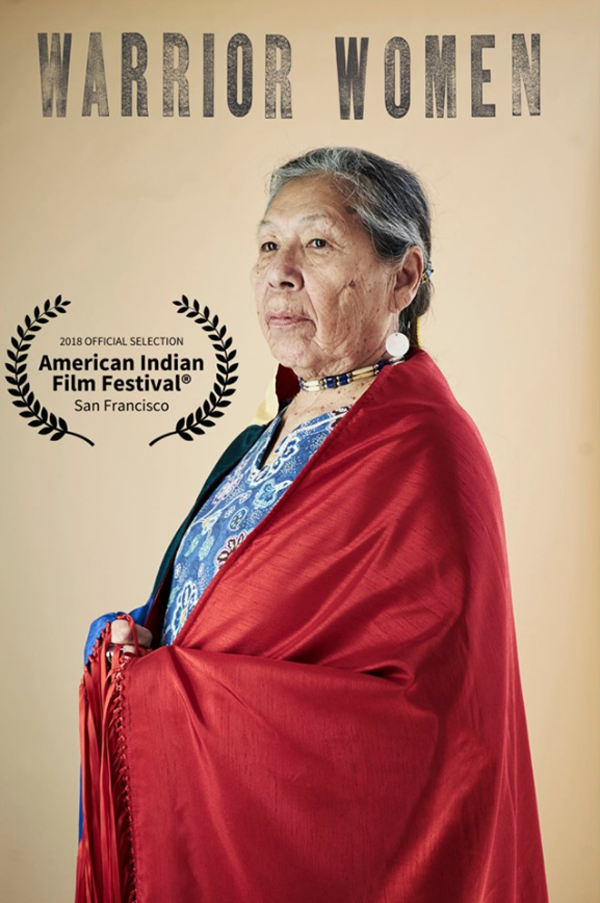
Sur la thématique de la lutte des femmes amérindiennes, le CSIA-Nitassinan s’est associé avec les réalisatrices Elisabeth Castle et Christina D. King (Séminole) et LARDUX Films pour la sortie en France et en Europe du film WARRIOR WOMEN.
Ce documentaire retrace le combat des femmes autochtones aux Etats-Unis des années 1970 jusqu’à nos jours, autour de la vie de Madonna Thunder Hawk (Sioux-Lakota, dirigeante de l’American Indian Movement et co-fondatrice de Women of All Red Nations – WARN) et de sa fille Marcy Gilbert. Un magnifique film à ne pas rater, notamment alors que 2019 marque les 50 ans de l’occupation de l’île d’Alcatraz, un événement majeur dans l’histoire moderne des peuples autochtones d’Amérique du nord.
Ce projet a été initié par le CSIA-Nitassinan, qui a réalisé la traduction et le sous-titrage du film en français. Le CSIA-Nitassinan a approché LARDUX Films pour sa distribution en France et en Europe.
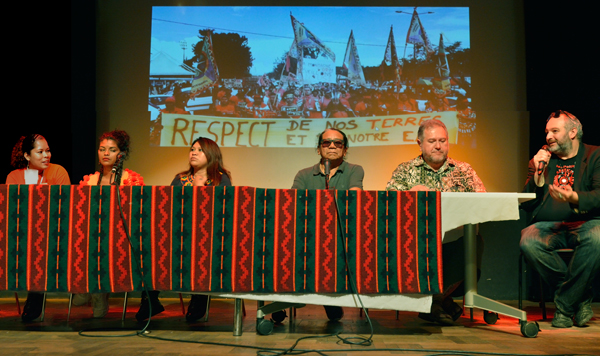 Vanessa Joseph, Cindy Van der Pijl, Nicole Chanel, Félix Tiouka, Moëtai Brotherson, Sylvain Duez-Alessandrini
Vanessa Joseph, Cindy Van der Pijl, Nicole Chanel, Félix Tiouka, Moëtai Brotherson, Sylvain Duez-Alessandrini
AGAINST THE GOLD COMPANY ‘MONTAGNE D’OR’, THE DENIAL OF THEIR IDENTITY, AND THE STRUGGLE FOR MOTHER EARTH: YOUNG WOMEN FROM FRENCH GUÏANA SPOKE, ON OCTOBER 13, 2018, DURING THE ‘SOLIDARITY DAY’ OF THE CSIA
Recorded on October 13th, 2018
Article and translation by Christine Prat Français
November 12th, 2018
The rainforest of “French” Guïana has been threatened for years by a huge gold mine project, by a mining company calling itself “Montagne d’Or”, meaning “Gold Mountain”. This company is a merger between the Canadian company Columbus Gold – could you think of a more colonialist name – and the Russian company NordGold, which has already devastated a lot of Indigenous lands in the world. NordGold has a majority in the Montagne d’Or merger. The Indigenous Peoples have opposed the project from the beginning. They have long suffered from illegal gold mining, namely from the garimpeiros from Brazil, which pollutes the rivers on which their lives depend. The rainforest of Guïana has more biodiversity than the whole of Europe. Some people there are willing to give it up with the excuse of ‘creating jobs’, the magical words that no magician would dare to use. The Indigenous Peoples, who mainly need clean water, and already felt the damages caused by gold mines, totally reject the project. Between the beginning of March 2018 and the beginning of July 2018, Public Hearings took place in Cayenne and Saint-Laurent-du-Maroni. Indigenous people had the feeling of not being heard. However, the conclusion of the public hearings was that the Montagne d’Or project could not be accepted as it is now. Since then, Montagne d’Or keeps going to Indigenous villages, trying to corrupt traditional leaders, but they don’t give in. The present Director General of Montagne d’Or, Pierre Paris, has worked before for companies as Rio Tinto and BHP Billiton, well-known names to Indigenous Peoples all over the world, who are fighting against desecration and pollution of their ancestral lands by mining companies.
As part of the 37th Day of Solidarity with Indigenous Peoples, organized by CSIA-nitassinan, a panel was composed of Félix Tiouka, member of the town council of Awala-Yalimapo, belonging to the first generation of Indigenous activists, and three young women from the Indigenous Youth of Guïana, JAG, Jeunesse Autochtone de Guyane.
As all Indigenous people who spoke during the meeting, the Indigenous people from Guïana spoke about the destruction of their identity and culture, but also about the problems they had with having to live as “so-called French citizens”, in a Republic that discriminates them, impoverishes them, pollutes their land, while forcing them to submit to the western way of life. “Départementalisation” – meaning that Guïana and other French colonies were officially annexed to France and considered as French “départements” (equivalent to US counties) – was declared in 1945. The “Francization” Act was adopted in 1969. Officially, Indigenous Peoples of Guïana are supposed to be French citizens like all inhabitants of France…
The article below is mainly based on a transcription of speeches by three young women from Guïana, Vanessa Joseph, Nicole Chanel and Cindy van der Pijl, recorded by Pascal Grégis and Christine Prat, members of CSIA, on October 13, 2018.
 Vanessa Joseph, vice-Chairperson of the Indigenous Youth of Guïana, already took part in the Solidarity Day of 2017, together with Yanuwana Tapoka. She first said how happy she was to take part in this meeting, “with Moëtai [from Tahiti], Yvannick [from Kanaky, “Nouvelle Calédonie] and my Uncle Félix [Félix Tiouka].” She thanked the CSIA for giving them an opportunity to speak, and also thanked all the people who had reacted to her appeal to donate books for schools inside the country. “We have used them well. Today, it has become a larger project, we are going to build libraries in remote places inside. All this thanks to you, I thank you again.” [In Guïana, the ‘inside’ means the rainforest, where there are no roads, as opposed to the cities on the coast or along the River].
Vanessa Joseph, vice-Chairperson of the Indigenous Youth of Guïana, already took part in the Solidarity Day of 2017, together with Yanuwana Tapoka. She first said how happy she was to take part in this meeting, “with Moëtai [from Tahiti], Yvannick [from Kanaky, “Nouvelle Calédonie] and my Uncle Félix [Félix Tiouka].” She thanked the CSIA for giving them an opportunity to speak, and also thanked all the people who had reacted to her appeal to donate books for schools inside the country. “We have used them well. Today, it has become a larger project, we are going to build libraries in remote places inside. All this thanks to you, I thank you again.” [In Guïana, the ‘inside’ means the rainforest, where there are no roads, as opposed to the cities on the coast or along the River].
However, Vanessa also had to say that the opening of the school year went wrong. She reminded that “inside the country, there are only primary school, and not in every village.” Students who have to go to secondary or grammar schools, must go to the nearest town which has one, but the ‘nearest’ town can be quite far away. The children then have to live with a foster family or in a boarding school. Last September, some children did not have a place in either a foster family or a boarding school. They went back to their villages, thus wasting a school year. Moreover, some parents don’t want to send their children to families on the coast, as there have been some problems. The only solution proposed by the Administration, each year, is to more carefully select the families. Vanessa says that “children in Taluwen, a town on the Upper Maroni, asked that a secondary school be built, so that they could stay near their parents, which is normal for 12-years-olds”… “At the moment, it is still a project. They started building, then stopped, then started again… Let’s hope that the secondary school will exist one day. They also started to build a boarding school in Maripasoula, again, we hope it will be completed without problems.”
Vanessa added that they are still trying to achieve projects in order to improve the people’s daily life, inside the country. When they succeed, it is thanks to a lot of support, like that of the CSIA.
Vanessa summed up what had happened about the gold mine project, since her last visit. Public hearings have been organized in Cayenne and in Saint-Laurent-du-Maroni, from the beginning of March to the beginning of July 2018.
“The representatives of the Indigenous Peoples have been kind of ignored, for what they had to say. At first, they listened to all questions, but then they started to select them, probably because there were disturbing questions.” …”a public hearing was planned in a village, west of the country, but they [from the company] did not show up.” Thus, the hearings were not very satisfying. However, “the public hearing decided: the project cannot be started as it is. It is not possible to propose such a large project to a population, with so few explanations and so unclear explanations. Thus, the project has to be amended.”
“Meanwhile, Vanessa adds, Montagne d’Or has stared to establish itself in the villages, demanding to meet the traditional leaders to offer them money or positions… It was a bit shocking, thus they all said ‘no’, except for one.” Currently, the Montagne d’Or company keeps trying to convince people, with some modifications of their project, and most of all by modifications of their explanations and communication. But for Indigenous people, it remains ‘no’.
Vanessa thanks the audience, “it is really a great pleasure to see you all again.”
 Next speaker is Nicole Chanel, from Camopi. She joined the Indigenous Youth recently.
Next speaker is Nicole Chanel, from Camopi. She joined the Indigenous Youth recently.
She explains that she is Teko, a People formerly called ‘Emérillon’ by French explorers, at the time of colonization. ‘Emérillons’ means people who live on fishing. “We demanded to be called Teko’s, which means ‘Indian Warriors’. We, Teko’s, come mainly from the banks of the Oyapock River, which is the border between Brazil and ‘France’. In our village, there were two nations, the Teko’s and the Wayãpi, but now we are mixed. We descend from the Tupi-Guarani, Indians who live in the Amazonian rainforest. Nowadays, the Tupi-Guarani live in Brazil. Some had to run away from wars, this is how we arrived in Camopi.”
In the past, an authorization from the ‘préfecture’ [representation of the French government in regions and counties] was needed to travel to our region. The reason given is that our people were still ‘savages’. Nicole says “we have never been savages. We always warmly welcomed the French people.” But now, it is open to anyone, which is not always an improvement. Nicole says “It takes 4 to 5 hours on a canoe to go to our region, because there are no roads, only the river. Everything is done by the river. Garimpeiros, gold seekers [from Brazil], come and dirty our water. The water we used to drink, that we used to wash ourselves in, that we used for everything. There are no customs, thus anybody can come. So, now, the garimpeiros come without problems, to seek gold. As they cannot do it where they live, they come to ‘French territory’. Then Nicole tells how she noticed that the water was polluted: “I grew up in Indian boarding schools from the age of 4 to 16. An Indian Boarding school is a place where they enlist Native American children who want to ‘become civilized’. They call it to get in line, to learn French, to learn to write, to count, etc. I came back home only in the summers, in July and August. So, in the course of time, when I came back home, I saw the color of the water changing. And I remembered that, as a small child, I used to wash myself in that water. I saw it become yellowish. At the point where it met the water dirtied by the garimpeiros, it formed a kind of white coffee. It looked disgusting.”
Nicole has been living in France for 15 years. She is astounded to see that the French State does nothing for Camopi. In July 2018, the Administration sent Mr. Jérôme Cahuzac, an ex-Minister now convicted to a jail sentence, to work at Camopi Health Center. Nicole says “he has nothing to do with Camopi” …”he is not a doctor”. As matter of fact, Mr. Cahuzac is a doctor, but a plastic surgeon. Nicole was shocked to see that media rushed to see Cahuzac while they showed no interest for the local population. Indigenous people resent it as despise. Of course, the media were interested in Cahuzac for his criminal record, not for political reasons.
Nicole closes her speech saying “In spite of this all, we fight, we shall fight, we Tekos, the Indigenous Youth, we shall fight to let people know, to let the world know, that we exist, that we are there. We are ‘French’, they put a label on us saying ‘French nationality’, thus we are part of France, thus look at us, look at our people! Thank you.”
 Then, Cindy Van der Pijl talked. Cindy still lives in Guïana and specially flew to Paris for the Solidarity Day. She is Arawak/Lokono.
Then, Cindy Van der Pijl talked. Cindy still lives in Guïana and specially flew to Paris for the Solidarity Day. She is Arawak/Lokono.
“I joined the Indigenous Youth in February of this year.” “I have always been claiming my culture ever since I was a small child. I was looking for an opening, a way to show my non-French identity. Because, back home, they teach us things, we learn all the time, but we are never taught who we are. In between, we are kind of lost in that French culture, in that westernized culture. Where do we stand, what should we do? Am I allowed to wear my traditional clothes, am I allowed to show my feathers without being arrested on the ground that they come from ‘protected species’?”
“Our Peoples have been tormented too long, so many tears have been shed, too many souls have been tortured, while the Earth is subjected to human selfishness and suffers even more than we do. They talk about Guïana, that ‘island’, but they never know where it is.” …”a lot of blood has been shed, and more will probably be shed, because of those ‘good ideas’ of the dominating powers.” Cindy wonders why, on the ‘united’ territory of the Republic, “where they tell us ‘Liberty, Equality and Fraternity’, they teach us to forget ourselves, to forget who we are. All our knowledge, our colors, our identity are trampled and shattered. Nicole’s story, she lived it, my mum lived it too. Indian Boarding Schools are not a myth, it really happened. There, French education is instilled, religion is instilled, it is part of a process of removing someone’s identity. It is as if we were made of clay that they can mold and shape as they want it to be. In Guïana, western culture, western people take and never give back.”
For Cindy, all that is left to Indigenous Peoples is the struggle. “The first Nation is reduced to the fight for its identity, to get its place in French society. For me, the word ‘Indigenous’ is equal to the word ‘struggle’… Is it normal that Indigenous people have to struggle to get their place and to be recognized? I don’t think so.
“Nowadays, we talk of looting. It is unfortunately not to be taken lightly. Apart from the crime of looting our identity, there is also the looting of She who gives us life, She who wakes up to remind the human being how small he is. We don’t always understand earthquakes, but they do happen. What if it were our Mother Earth being angry at us? At all we do to Her? She is the one who feeds us, She is our Mother Earth. Our ancestors bequeathed their struggle to us. Today, we, the youth, are trying to take over that struggle. But rather than being victims of this system, although we are, we are warriors. And with this, I join with all my Indigenous Brothers. My Kanak brothers, going through a difficult situation, and all our other Indigenous brothers. We are all warriors and I am happy about that, otherwise we would not be here today. We would be good little French people who believe in Jesus.”
Then, Cindy talked about Montagne d’Or. “Why won’t we give in to Montagne d’Or? The answer is simple and logical: we are fighting for the Earth, we are fighting for life.” As human beings, what we need most is drinking water, eating, walking… All this is given by the Earth.
“For those who don’t know, Montagne d’Or is a huge project that tries to establish itself in Guïana. It is a Russian-Canadian merger now called Montagne d’Or, Pierre Paris being the new director. Montagne d’Or means 80,000 tons of waste a day, 10 tons of cyanide a day, 10 tons of explosives, about 125,000 gallons of water PER HOUR, when the population is doing badly. Montagne d’Or would be an open site, in a tropical zone where it often rains. Thus, when they tell us there won’t be any accident, it’s difficult to believe.”
“I took part in the public hearings, in Saint-Laurent-du-Maroni and in Cayenne. You can’t believe how those people make you feel small. How tough you must be to tell them ‘no’. Seeing Pierre Paris stand up and say ‘I am Pierre Paris and I am proud to be the director of Montagne d’Or’, ideas of murder can cross your mind… But we stood our ground, we showed our colors, we showed that we were there. The youth was there, the Elders were there, as well as people from all cultures of Guïana who stood with us…” “Those cultures understood that it is a human struggle, a struggle for life, we are going to fight it, to fight to the end. I also would like people to realize what our societies are doing to us, with that capitalist culture. Shall we ever be able to see money for what it truly is, a piece of paper? Shall we ever be able to see gold for what it really is, a piece of stone? It is those things that the world is fighting for, that people kill each other for. It’s because of them that blood is shed, again and again.”
“Finally, I would like to thank you for listening to me, I am very happy to be here. I thank the CSIA for inviting us, and allowing us to speak on this French land. Tomorrow, I shall fly back home. My fight goes on and I really wish that the youth, of whatever culture, ally with us against this project. The problem of our identity, as Indigenous, is our history. We shall fight Montagne d’Or too, with the same virulence. I thank you for listening to me.”
 Vanessa Joseph, Cindy van der Pijl, Nicole Chanel, Félix Tiouka, Moëtai Brotherson et Sylvain Duez-Alessandrini
Vanessa Joseph, Cindy van der Pijl, Nicole Chanel, Félix Tiouka, Moëtai Brotherson et Sylvain Duez-Alessandrini
CONTRE MONTAGNE D’OR, LA NEGATION DE L’IDENTITE, ET POUR LE COMBAT POUR LA TERRE: DES JEUNES FEMMES DE GUYANE SE SONT EXPRIMEES, LE 13 OCTOBRE 2018, LORS DE LA JOURNEE DE SOLIDARITE DU CSIA.
Christine Prat
10 novembre 2018
Enregistrement 13 octobre 2018
Depuis plusieurs années, une partie de la forêt amazonienne de Guyane “française” est menacée par un projet de mine d’or monumental, mené par une compagnie intitulée “Montagne d’Or”, résultat d’une fusion entre la compagnie canadienne Columbus Gold – en tant que nom colonial, on peut difficilement faire mieux – et la compagnie russe NordGold, qui a déjà ravagé beaucoup de terres Autochtones dans le monde. NordGold est majoritaire dans Montagne d’Or. Les Autochtones s’opposent depuis le début au projet. Ils sont déjà depuis longtemps confrontés aux chercheurs d’or illégaux, les garimpeiros venus du Brésil, qui polluent énormément les rivières dont leur vie dépend. La forêt amazonienne de Guyane a une biodiversité beaucoup plus importante que celle de toute l’Europe. Certains sont prêts à en sacrifier une partie, sous prétexte de “créer des emplois”, formule devenue magique, qu’aucun druide ou magicien n’oserait utiliser. Les Autochtones, qui ont surtout besoin d’eau potable et ont déjà constaté les dégâts que les mines d’or y causent, s’opposent absolument au projet. De début mars à début juillet 2018, des “débats publics” ont eu lieu à Cayenne et à Saint-Laurent-du-Maroni. Les Autochtones ont eu l’impression de ne pas y être écoutés. Cependant, la conclusion a été que le projet Montagne d’Or ne pouvait pas être accepté en l’état. Depuis, Montagne d’Or multiplie les contacts et les tentatives de corruption dans les villages Autochtones. Cependant, l’opposition reste ferme. L’actuel Directeur Général de Montagne d’Or, Pierre Paris, a travaillé précédemment pour des firmes comme Rio Tinto et BHP Billiton, noms bien connus des Peuples Autochtones, un peu partout dans le monde, qui se battent contre la profanation et la pollution de leurs terres ancestrales par les compagnies minières.
Au cours de la 37ème Journée de Solidarité avec les Peuples Autochtones, organisée par le CSIA-nitassinan, une table ronde a réuni Félix Tiouka, 1er adjoint au maire d’Awala-Yalimapo, issu de la première génération d’activistes Autochtones, et trois jeunes femmes de la Jeunesse Autochtone de Guyane.
Comme tous les Autochtones qui sont intervenus lors de cette rencontre, les Autochtones de Guyane ont parlé de la destruction de leur identité et de leur culture, mais aussi de leur difficulté à vivre en tant que “citoyens soi-disant Français” dans une République qui les discrimine, les appauvrit, pollue leur terre, tout en voulant les forcer à se soumettre au “mode de vie” occidental. La “départementalisation” a été décrétée en 1945, la Loi de “Francisation” en 1969. Théoriquement, les Autochtones de Guyane sont des citoyens français comme les autres…
L’article ci-dessous est fondé sur les interventions des trois jeunes femmes, Vanessa Joseph, Nicole et Cindy van der Pijl, d’après des enregistrements réalisés par Pascal Grégis et Christine Prat, membres du CSIA, le 13 octobre 2018.
 Vanessa Joseph, Vice-présidente de la Jeunesse Autochtone de Guyane, avait déjà participé à la Journée de Solidarité du CSIA de 2017, en compagnie de Yanuwana Tapoka. Elle a d’abord dit combien elle était heureuse de participer à cette rencontre, “avec Moëtai [de Tahiti], Yvannick [de Kanaky, ou “Nouvelle Calédonie”] et mon Tonto Félix [Félix Tiouka].” Elle a remercié le CSIA de leur fournir cette opportunité de s’exprimer, puis toutes les personnes qui avaient répondu à son appel pour des dons de livres, à l’intention des écoles de l’intérieur. “Nous en avons fait un très bon usage. Aujourd’hui, c’est devenu un projet un peu plus grand, nous allons construire des bibliothèques à l’intérieur. Tout ça, c’est grâce à vous, merci encore.”
Vanessa Joseph, Vice-présidente de la Jeunesse Autochtone de Guyane, avait déjà participé à la Journée de Solidarité du CSIA de 2017, en compagnie de Yanuwana Tapoka. Elle a d’abord dit combien elle était heureuse de participer à cette rencontre, “avec Moëtai [de Tahiti], Yvannick [de Kanaky, ou “Nouvelle Calédonie”] et mon Tonto Félix [Félix Tiouka].” Elle a remercié le CSIA de leur fournir cette opportunité de s’exprimer, puis toutes les personnes qui avaient répondu à son appel pour des dons de livres, à l’intention des écoles de l’intérieur. “Nous en avons fait un très bon usage. Aujourd’hui, c’est devenu un projet un peu plus grand, nous allons construire des bibliothèques à l’intérieur. Tout ça, c’est grâce à vous, merci encore.”
Cependant, Vanessa dit aussi que la rentrée scolaire de septembre dernier ne s’est pas bien passée. Elle rappela “qu’à l’intérieur il y a seulement des écoles élémentaires, et pas forcément dans tous les villages.” Les enfants qui doivent aller au collège ou au lycée, doivent partir dans la commune la plus proche ayant un collège ou un lycée, et la commune ‘la plus proche’ peut être très éloignée. Les enfants doivent donc résider dans une famille d’accueil ou un internat. En septembre dernier, certains enfants n’avaient trouvé ni famille d’accueil, ni place en internat. Ils sont retournés dans leur village, et vont perdre une année scolaire. De plus, certains parents ne veulent plus envoyer leurs enfants dans des familles du littoral, vu qu’il y a eu des incidents. L’éducation nationale propose toujours la même solution: mieux sélectionner les familles d’accueil. Vanessa raconte: ” Il y a des enfants de Taluwen, une commune sur le Haut-Maroni, qui ont demandé la construction d’un collège, pour pouvoir rester auprès de leurs parents, ce qui est normal, à 12 ans”… “Pour l’instant, c’est un projet. Ils ont commencé la construction, elle s’est interrompue, puis a été relancée. Espérons que le collège voit le jour. Il y a également un internat en construction à Maripasoula, là aussi nous espérons que ça se déroule sans embûches.”
Vanessa ajoute qu’ils essaient tout de même de faire aboutir certains projets, pour améliorer le quotidien des gens de l’intérieur. Et s’ils peuvent y arriver, c’est grâce à de nombreux soutiens, comme le CSIA.
Vanessa a aussi résumé ce qui s’était passé sur le front de la Montagne d’Or depuis sa dernière visite. Des débats publics ont été organisés à Cayenne et à Saint-Laurent-du-Maroni, de début mars à début juillet. Vanessa dit que “ce fut très intense.”
“Les représentants des Peuples Autochtones ont été un peu ignorés, pour ce qu’ils avaient à dire. Au départ, ils écoutaient toutes les questions, au final, ils ont commencé à les sélectionner, parce que, je pense, certaines questions dérangeaient.” …” Un débat public devait être organisé dans un village de l’ouest, ils n’ont pas honoré ce rendez-vous.” Donc, ça ne s’est pas très bien passé. Pourtant, “par la suite, le débat public a tranché: le projet ne peut pas se faire en l’état. On ne peut pas proposer à une population un projet de cette ampleur avec aussi peu d’explications, et des explications qui ne sont pas claires du tout. Donc, pour le moment, c’est un projet qui doit être révisé.”
Vanessa précise: “Entretemps, la compagnie Montagne d’Or a commencé à s’implanter dans les villages, à convoquer les chefs coutumiers, à leur faire des propositions, que ce soit de l’argent ou des postes… C’était un peu n’importe quoi, donc ils ont tous dit non, sauf un.” Et, à l’heure actuelle, la compagnie Montagne d’Or continue d’essayer de convaincre les gens, avec quelques modifications de son programme, et surtout des modifications de ses explications et de sa communication. Mais, pour les Autochtones, ça reste ‘non’.
Vanessa conclut en remerciant l’assistance, “c’est vraiment un grand plaisir de vous voir et de vous revoir.”
 L’intervenante suivante, Nicole Chanel, est originaire de Camopi. Elle a rejoint la Jeunesse Autochtone récemment.
L’intervenante suivante, Nicole Chanel, est originaire de Camopi. Elle a rejoint la Jeunesse Autochtone récemment.
Elle explique qu’elle est Teko, un Peuple appelé autrefois ‘Emérillon’ par des explorateurs français venus à l’époque de la colonisation. ‘Emérillons’ signifie les gens qui vivent de la pêche. “Et nous avons revendiqué d’être appelés les Tekos, ce qui veut dire ‘Indiens guerriers’. Nous, les Tekos, venons de Camopi, principalement des bords du fleuve Oyapock, qui sert de frontière entre le Brésil et “la France”. Dans notre village, il y a deux ethnies, les Tekos et les Wayampis, mais maintenant, nous sommes mélangés. Nous sommes des descendants des Tupi-Guarani, des Indiens qui vivent dans la forêt Amazonienne. Actuellement, les Tupi-Guarani vivent au Brésil. Certains ont fui des guerres, et c’est ainsi que nous sommes arrivés à Camopi.”
Autrefois, il fallait une autorisation préfectorale pour se rendre dans la région. Le prétexte était que les gens de là-bas étaient encore “sauvages”. Nicole dit, “nous n’avons jamais été sauvages. Nous avons toujours accueilli les Français à bras ouverts.” Mais maintenant, c’est ouvert à tout le monde, ce qui n’est pas forcément un avantage. Nicole raconte: “Pour aller chez nous, il faut 4 ou 5 heures de pirogue, parce qu’il n’y a pas de routes, c’est le fleuve. Tout ce fait par le fleuve. Il y a des garimpeiros, des chercheurs d’or [du Brésil], qui passent salir notre eau. L’eau qu’on buvait, dans laquelle on se lavait, où on faisait tout. Comme il n’y a pas de douane, tout le monde peut venir. Alors maintenant, les garimpeiros rentrent sans soucis, pour aller chercher de l’or, parce que chez eux, ils ne peuvent pas le faire, donc ils viennent en territoire ‘français’, pour le faire.” Et Nicole raconte comment elle s’est aperçue de la pollution de l’eau: “Moi, j’ai grandi dans les homes indiens de 4 à 16 ans. Le home indien est un endroit où ils accueillent les enfants Amérindiens qui veulent être ‘civilisés’. Eux appellent ça rentrer dans le rang, apprendre à parler français, apprendre à écrire, à compter, etc. Je ne rentrais que pendant les étés, en juillet et août. Mais au fur et à mesure, en rentrant chez moi, je voyais que l’eau changeait de couleur. Et je me disais que, petite, je me lavais dans cette eau, et d’autres choses comme ça. Et je voyais l’eau devenir jaunâtre. Au point de rencontre de l’eau salie par les garimpeiros avec celle dans laquelle on se lavait, se formait un genre de café au lait. C’était dégueulasse à voir.”
Nicole vit en France depuis 15 ans. Elle est abasourdie de constater que l’Etat Français ne fait rien pour Camopi. En juillet dernier, l’administration a envoyé, pour assurer un remplacement au Centre de Santé de Camopi, M. Jérôme Cahuzac, un ex-Ministre actuellement condamné à 4 ans de prison, dont 2 avec sursis. Pour Nicole, M. Cahuzac “n’a rien à voir avec Camopi. Ils l’ont envoyé là-bas pour travailler dans un centre de santé, alors qu’il n’est pas médecin”. En réalité, M. Cahuzac est médecin, mais chirurgien esthétique. Nicole s’indigne de ce que les médias s’étaient tous précipité à Camopi pour voir Cahuzac, sans montrer le moindre intérêt pour la population locale. C’est bien entendu à cause de ses déboires en justice que les médias s’intéressent à M. Cahuzac. Certains ont demandé à des habitants ce qu’ils pensaient de Cahuzac, et ils ont répondu: “Mais qu’est-ce qu’on sait de lui?” Tout cela est ressenti par les Autochtones comme un profond mépris.
Nicole conclut: “Malgré tout cela, nous nous battons, nous allons nous battre, nous les Tekos, la Jeunesse Autochtone, nous battre pour nous faire connaître du public, de tout le monde, pour dire que nous existons, que nous sommes là. Nous sommes des ‘Français’, on nous a mis une étiquette ‘nationalité française’, donc nous faisons partie de la France aussi, alors regardez-nous, regardez notre Peuple. Merci.”
 Puis, Cindy van der Pijl prit la parole. Cindy vit toujours en Guyane et est venue spécialement pour la Journée de Solidarité. Elle est Arawak/Lokono.
Puis, Cindy van der Pijl prit la parole. Cindy vit toujours en Guyane et est venue spécialement pour la Journée de Solidarité. Elle est Arawak/Lokono.
“Je fais partie de la Jeunesse Autochtone depuis février de cette année”. “J’ai toujours été très passionnée, très revendicatrice de ma culture, depuis que j’étais toute petite. Je cherchais une ouverture quelque part, à savoir comment faire pour montrer mon identité autre que française. Parce que, chez nous, on nous apprend des choses, on nous apprend tout le temps, mais on ne nous apprend jamais qui on est. Et, forcément, au bout d’un moment, nous sommes un peu perdus dans cette culture française, dans la culture de l’occidentalisation. Où se positionner, comment faire? Est-ce que j’ai le droit de porter ma tenue, est-ce que j’ai le droit de montrer mes plumes sans que la douane vienne m’arrêter parce que ce sont des espèces protégées?”
“Nos peuples ont été trop longtemps martyrisés, beaucoup de larmes ont été versées, beaucoup trop d’âmes ont été torturées, tandis que la Terre subit l’égoïsme de l’être humain et souffre encore plus que nous-mêmes. On parle de la Guyane, cette fameuse “île”, mais on ne sait pas où elle se trouve.” …”beaucoup de sang a coulé, et coulera sûrement encore, à cause des ‘bonnes idées’ de nos puissances.” Cindy se demande pourquoi, sur le territoire de la République, “où on nous dit ‘Liberté, Egalité, Fraternité’, on nous apprend tellement à nous oublier, à ne plus savoir que nous sommes. Tous nos savoirs, nos couleurs, notre identité, sont comme piétinés, complètement bafoués. L’histoire de Nicole, elle l’a vécue, ma maman l’a également vécue, les homes indiens ne sont pas un mythe, ça s’est vraiment passé. L’éducation française y est inculquée, la religion y est inculquée, ça fait partie d’un processus d’enlèvement de l’identité d’une personne. C’est comme si nous étions faits de pâte à modeler qu’on façonne comme on veut, comme on souhaite qu’elle soit. En Guyane, la culture occidentale, les occidentaux, prennent et ne rendent pas.”
Pour Cindy, tout ce qui reste aux Autochtones, c’est la lutte. ” La place du Peuple Premier est réduite aujourd’hui à se battre pour une reconnaissance de son identité, pour avoir sa place dans la société française. Pour moi, aujourd’hui, le mot ‘Autochtone’ est égal au mot ‘lutte’… ” Est-ce que c’est normal que les Autochtones doivent se battre, pour avoir une place et pour qu’on les reconnaisse? Je ne pense pas.
“Aujourd’hui, on parle de pillage. Malheureusement, ce n’est pas un terme à prendre à la légère, car en dehors de ce crime, le pillage identitaire, il y a le pillage de Celle qui nous donne vie, Celle qui se réveille pour rappeler à l’homme sa petitesse. Les tremblements de terre, les séismes, on ne le comprend pas toujours, mais ça arrive quand même. Et si jamais la Maman Terre était en colère contre nous? Contre tout ce que nous lui faisons subir? C’est Celle qui nous berce, Celle qui nous nourrit, notre Maman la Terre. Nos ancêtres nous ont légué leur combat. Aujourd’hui, nous, la jeunesse, essayons de reprendre ce combat. Mais plutôt que d’être des victimes de ce système, même si, au fond, nous le sommes quand même, nous sommes des guerriers. Et là, je rassemble vraiment tous mes frères Autochtones. Mes frères Kanaks, passant par quelque chose qui n’est vraiment pas facile pour eux, et tous nos autres frères Autochtones. Nous sommes tous des guerriers et j’en suis heureuse, parce que sinon, aujourd’hui, nous ne serions pas là. Nous serions de bons petits Français qui croient en Jésus.”
Ensuite, Cindy parle du projet Montagne d’Or. ” Pourquoi ne lâcherons-nous pas face à Montagne d’Or? La réponse est simple et logique. Nous nous battons pour la Terre, nous nous battons pour la vie. Je me demande, en tant qu’être humain, ce dont nous avons le plus besoin dans nos vies. Nous avons besoin de boire de l’eau potable, nous avons besoin de manger, nous avons besoin de marcher, sur qui? Et qui nous donne tout ça? Encore une fois, c’est la Terre.”
“Montagne d’Or, pour ceux qui ne le savent pas, c’est un projet monumental qui veut s’installer en Guyane. C’est une fusion russo-canadienne qui s’appelle maintenant Montagne d’Or, dont Pierre Paris est le directeur général. Montagne d’Or, c’est 80 000 tonnes de déchets par jour, c’est 10 tonnes de cyanure par jour, 10 tonnes d’explosifs, 472 000 litres d’eau PAR HEURE, quand une population va mal. Montagne d’Or est un site à ciel ouvert, dans une zone tropicale où il pleut souvent. Alors, nous dire qu’il n’y aura pas d’accidents, j’ai du mal à le croire.”
“J’ai participé aux débats publics, qui ont eu lieu à Saint-Laurent-du-Maroni et à Cayenne. Vous n’imaginez pas à quel point on se sent petit face à ces gens-là. A quel point il faut s’affirmer pour leur dire ‘non’. Quand on voit un Pierre Paris qui se lève et qui dit “Je suis Pierre Paris et fier d’être le directeur de la Montagne d’Or”, ça donne des envies de crime, parfois… Mais en tous cas, nous avons tenu bon, nous avons montré nos couleurs, montré que nous étions là. Il y avait la jeunesse, il y avait les Anciens, il y avait aussi toutes les cultures guyanaises qui se sont mises avec nous, parce que ces cultures-là ont compris que, si nous arrivons à faire en sorte que la Montagne d’Or ne se fasse pas, la Terre ne va pas leur dire ‘Cindy m’a sauvée, alors que toi, je m’en fous’, non, pas du tout. Ces cultures-là ont compris qu’il s’agit d’un combat humain, que c’est un combat pour la vie, et nous le mènerons, nous irons jusqu’au bout. Et j’aimerais qu’à un moment donné, on puisse se rendre compte de ce que nos sociétés sont en train de nous faire, avec cette culture du capitalisme. Est-ce qu’un jour on pourrait réduire l’argent à ce qu’il est vraiment? Un morceau de papier. Est-ce qu’un jour on pourrait réduire l’or à ce que réellement? Un petit bout de caillou. Et ce sont ces choses pour lesquelles le monde se bat, pour lesquelles les gens s’entretuent. C’est à cause de ça que le sang coule, et coule encore.”
“Pour conclure, j’aimerais vous remercier de m’avoir écoutée, et je suis très contente d’être ici. Je remercie le CSIA de nous avoir invités, et de nous avoir permis quand même d’avoir la parole sur cette terre française. Demain, je rentre chez moi, mon combat continue et j’aimerais vraiment que la jeunesse, quelle que soit sa culture, puisse s’allier à nous face à ce projet. Le problème autour de notre identité, de l’Autochtone, c’est notre histoire. Nous nous battrons contre Montagne d’Or aussi, et sûrement avec la même virulence.
Je vous remercie de m’avoir écoutée.”
COLONIALISTS WIN REFERENDUM IN KANAKY (“NOUVELLE CALEDONIE”) REPRESENTATIVE OF YOUNG KANAKS IN FRANCE SPOKE AT CSIA DAY OF SOLIDARITY
By Christine Prat, CSIA Français
November 4th, 2018
Also published on Censored News
Today, November 4th 2018, the colonialists won the referendum by which, inhabitants of Kanaky – so-called New Caledonia – had to decide for or against Independence. Supporters of colonialism won with a much fewer votes than expected. However, settlers of European origin being now in greater numbers than Indigenous people, they could still win.
A few decades ago, tensions raised, as France was encouraging massive European immigration. Violent incidents took place in the 1980s. Two agreements were signed, in Paris in 1988, and in Nouméa in 1998. This agreement decided that several referendums would be held, in which only people already living in Kanaky in 1998 and their descent could take part. However, the immigration policy had started earlier, so that settlers arrived before 1998 are more numerous than Indigenous people.
Kanaky – ‘Nouvelle Calédonie’ – is on top of the United Nations list of countries to be decolonized. However, it is one of the biggest nickel producers on earth. Indigenous people and environmentalists say that digging mines for nickel is destroying the country, which is home to rare species, to exceptional fauna and flora. Those who oppose independence claim that, if France pulled out, the country would necessarily fall under Chinese influence. But this would mean that the world and Kanaky would remain submitted to capitalism, that will go on exploiting nickel until the land is totally destroyed.
 On October 13th 2018, a delegation of young Kanaks, led by Yvannick Waikata, spoke person for the Young Kanaks Movement in France, was invited to the Annual Day of Solidarity organized by CSIA-nitassinan, the French Committee for Solidarity with Indians of the Americas. This year, Native Americans from the USA, Chili, Argentina and “French” Guyana were speakers at the event.
On October 13th 2018, a delegation of young Kanaks, led by Yvannick Waikata, spoke person for the Young Kanaks Movement in France, was invited to the Annual Day of Solidarity organized by CSIA-nitassinan, the French Committee for Solidarity with Indians of the Americas. This year, Native Americans from the USA, Chili, Argentina and “French” Guyana were speakers at the event.
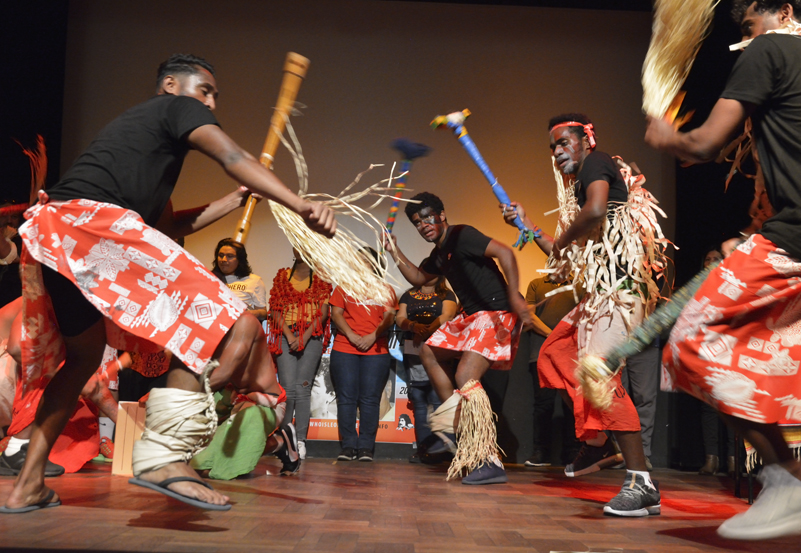 The Young Kanaks offered a traditional dance to welcome the Indigenous guests from the Americas.
The Young Kanaks offered a traditional dance to welcome the Indigenous guests from the Americas.
Yvannick first explained the meaning of the dance. He said the purpose was to bow before the guests and audience, as, in their country, doors are low so that they must bow to enter someone’s house. Bowing also means that they apologize as they are going to make noise. Originally, the purpose of the dance is to initiate young men to the art of war. It is also meant to show ‘their face’. Thus, the purpose of this dance was to show ‘their face’, their identity, for which they have been struggling since 1853. Yvannick said “since that old cloth is flown above our stone (Kanaky), the flag of that colonial empire”.
Yvannick spoke for the Young Kanaks in France. He spoke about the referendum that was to take place on November 4th, explaining: “Why a self-determination referendum? Because we are in a situation of colonizer to colonized. Those who will take part in this referendum are the colonized, us, the Kanaks. ‘Kanak’ is a Hawaiian word meaning ‘human being’.”
Then he went on summing up their history: the colonial conquest began in Tasmania, and in Hawaii. The French colonial empire started in “New Caledonia”, an island thus named by James Cook in 1774. The French conquered it in 1853. The goal was, ultimately, the end of the Kanak People.
 This is because of the denial of the Kanak People that they danced that day. “… when we dance somewhere, it is to show our identity, and that we are still alive”. Since 1774 and 1853, and later the policy of European immigration, the French have been trying to drown the Indigenous claim. So, they dance, to say they are still there, they still exist.
This is because of the denial of the Kanak People that they danced that day. “… when we dance somewhere, it is to show our identity, and that we are still alive”. Since 1774 and 1853, and later the policy of European immigration, the French have been trying to drown the Indigenous claim. So, they dance, to say they are still there, they still exist.
 Yvannick reminded the audience that the murdered leader Jean-Marie Tjibaou, had organized the Festival ‘Melanesia 2000’. For that festival, the Indigenous people decided that they would no longer limit their sacred dances and cultural practices to ceremonies, but that they would show them publicly to affirm their existence. They wanted to break completely with what had been shown in France before, during ‘colonial exhibitions’. He stressed that it was important for them to dance in Paris before the referendum, to show their faces, their culture, their identity and their history. “Our history does not start with French colonization”. So, since ‘Melanesia 2000’, their struggle was “to place the Kanak claim for identity, the cultural field, into the political field”.
Yvannick reminded the audience that the murdered leader Jean-Marie Tjibaou, had organized the Festival ‘Melanesia 2000’. For that festival, the Indigenous people decided that they would no longer limit their sacred dances and cultural practices to ceremonies, but that they would show them publicly to affirm their existence. They wanted to break completely with what had been shown in France before, during ‘colonial exhibitions’. He stressed that it was important for them to dance in Paris before the referendum, to show their faces, their culture, their identity and their history. “Our history does not start with French colonization”. So, since ‘Melanesia 2000’, their struggle was “to place the Kanak claim for identity, the cultural field, into the political field”.
After that summary of the history from the 1980s to today, Yvannick said “We, the young people, are the generation born from those peace agreements. There have been two agreements, that of Matignon in 1988 et that of Nouméa in 1998. We are the generation that lived through that peace. For the November 4 referendum, the Young Kanaks Movement creates spaces to speak, to awake the awareness among our people. Of course, we did not live the civil war situation in ‘Nouvelle Calédonie’, those ‘events’, as historians put it, but it was a war, it actually was an independence war”.
The Young Kanaks Movement works to awake awareness about the Kanak People history, in particular that of the heroes of the struggle, as the French National Education does not do anything, does not even mention the Kanak People.
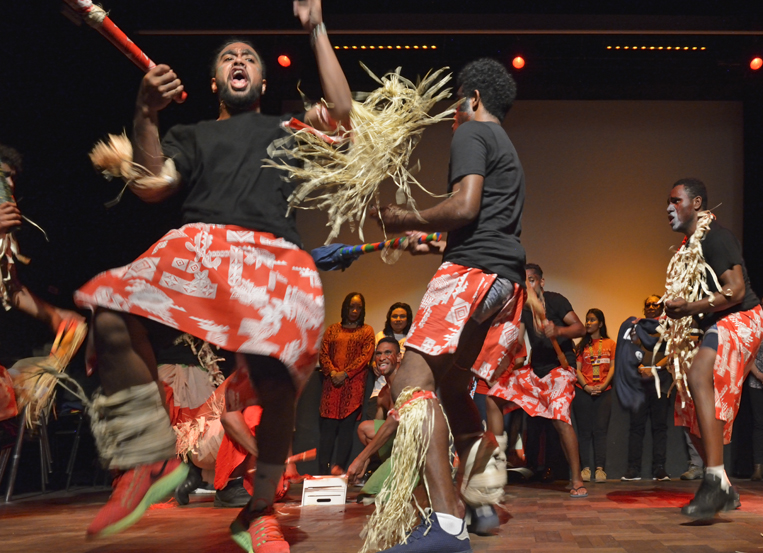 What the Young Kanaks Movement wants is an identity revival. Yvannick says “for us, it is important that you can identify us and see who we are. Not reduce us to what colonial exhibitions produced in the collective imagination of the French People. So, it is important to dance and show our culture. To come nearer, to learn to know each other. We do not blame the French People at all, we blame the colonial administration.” He added “you are also human beings, like us, so we can reach you”. The colonial exhibitions created an imaginary Other, supposed to be a savage. “At the last colonial exhibition, there was Christian Karembeu’s – star of the French National Football Team – grandfather. His grandfather was a school master in “Nouvelle Calédonie”, but he came here to impersonate a savage!”
What the Young Kanaks Movement wants is an identity revival. Yvannick says “for us, it is important that you can identify us and see who we are. Not reduce us to what colonial exhibitions produced in the collective imagination of the French People. So, it is important to dance and show our culture. To come nearer, to learn to know each other. We do not blame the French People at all, we blame the colonial administration.” He added “you are also human beings, like us, so we can reach you”. The colonial exhibitions created an imaginary Other, supposed to be a savage. “At the last colonial exhibition, there was Christian Karembeu’s – star of the French National Football Team – grandfather. His grandfather was a school master in “Nouvelle Calédonie”, but he came here to impersonate a savage!”
“When we come to dance here, it is to decolonize ourselves. The message we bring is to learn to know each other, through the Kanak People’s struggle. I want to thank you for being here and I hope we shall remain connected. We still need you, we still need solidarity. Thank you.”
LES COLONIALISTES REMPORTENT LE REFERENDUM EN KANAKY (“NOUVELLE CALEDONIE”). LE PORTE-PAROLE DES JEUNES KANAKS EN FRANCE EN PARLAIT LORS DE LA JOURNEE DE SOLIDARITE DU CSIA-NITASSINAN
Par Christine Prat, CSIA English
Also in English on Censored News
Rennes, France, 4 novembre 2018 – Aujourd’hui, les colonialistes ont remporté le référendum par lequel les habitants de Kanaky – soi-disant Nouvelle Calédonie – devaient se prononcer pour ou contre l’indépendance. Les partisans du colonialisme ont gagné avec un pourcentage bien moindre que ce qu’ils escomptaient. Cependant, les gens d’origine européenne étant maintenant plus nombreux que les Autochtones, ils ont remporté le scrutin.
Il y a quelques décennies, la situation politique s’était tendue, du fait que la France encourageait beaucoup l’immigration européenne. Des incidents violents avaient eu lieu au cours des années 1980, le plus connu des médias étant la prise en otage de gendarmes dans la grotte d’Ouvéa, en 1988 (auparavant, des indépendantistes avaient été tués). Finalement, en 1998, un accord a été conclu, prévoyant plusieurs référendums, auxquels seuls les gens habitant déjà en “Nouvelle Calédonie” en 1998 et leurs descendants pourraient prendre part. Mais la politique d’immigration avait eu lieu avant, donc les Européens et leurs descendants déjà présents en 1998 sont majoritaires.
La Kanaky – “Nouvelle-Calédonie” – est en tête de la liste des Nations Unies de pays qui devraient être décolonisés. Cependant, c’est l’un des plus grands producteurs de nickel au monde. Non seulement les Autochtones, mais aussi la plupart des écologistes, disent que l’exploitation du nickel risque de détruire une bonne partie du pays, qui héberge une faune et une flore exceptionnelles, inconnues ailleurs. Les adversaires de l’indépendance clament que si la France se retirait, le pays tomberait forcément sous l’influence de la Chine. Mais cela implique que le monde en général et la Kanaky en particulier, restent soumis au régime capitaliste, qui continuera à exploiter le nickel jusqu’à la destruction complète.
 Le 13 octobre 2018, une délégation de jeunes Kanaks, conduite par Yvannick Waikata, porte-parole du Mouvement des Jeunes Kanaks en France, était invitée à la Journée Annuelle de Solidarité avec les Peuples Autochtones du CSIA-nitassinan, Comité pour la Solidarité avec les Indiens des Amériques.
Le 13 octobre 2018, une délégation de jeunes Kanaks, conduite par Yvannick Waikata, porte-parole du Mouvement des Jeunes Kanaks en France, était invitée à la Journée Annuelle de Solidarité avec les Peuples Autochtones du CSIA-nitassinan, Comité pour la Solidarité avec les Indiens des Amériques.
 Les jeunes Kanaks ont offert une danse traditionnelle, pour souhaiter la bienvenue aux invités Autochtones des Amériques, venus des Etats-Unis, du Chili, d’Argentine et de Guyane “Française”.
Les jeunes Kanaks ont offert une danse traditionnelle, pour souhaiter la bienvenue aux invités Autochtones des Amériques, venus des Etats-Unis, du Chili, d’Argentine et de Guyane “Française”.
Yvannick a d’abord expliqué la signification de la danse. Il dit qu’il s’agissait de se courber devant les hôtes, parce que dans leur pays, les portes des maisons sont basses et qu’il faut se baisser pour entrer chez quelqu’un. Donc, la danse avait aussi pour but de se courber devant les invités et spectateurs, ce qui signifie aussi qu’ils s’excusent parce qu’ils vont faire du bruit. Au départ, c’est une danse d’initiation à l’art de la guerre, et c’est une façon pour les jeunes de montrer ‘leur visage’. Donc, cette danse avait pour but de montrer leur visage, leur identité, pour laquelle ils luttent depuis 1853. Yvannick dit “depuis qu’un vieux chiffon flotte sur le caillou (“Kanaky”), le drapeau de cet empire colonial”.
Yvannick est intervenu en tant que porte-parole des Jeunes Kanaks en France. Il a rappelé qu’un référendum allait avoir lieu le 4 novembre et expliqué: “Pourquoi un référendum d’autodétermination? C’est parce que nous sommes dans une situation de colonisateur à colonisés. Et ceux qui participeront à ce référendum sont les colonisés, donc nous, les Kanaks. Ce mot, “Kanak”, est un mot hawaïen qui veut dire ‘homme’.”
Puis il résuma l’histoire: l’entreprise coloniale dans le Pacifique a commencé en Tasmanie, et à Hawaï. L’empire colonial français l’a entreprise en “Nouvelle Calédonie”, une île baptisée par James Cook en 1774. Les Français l’ont conquise en 1853. Le but de l’entreprise était, à terme, la disparition du peuple Kanak.
 C’est à cause de la négation du peuple Kanak qu’ils ont dansé ce jour-là. “…quand on vient danser, c’est pour montrer notre identité, que nous sommes en vie”. Depuis 1774 et 1853, l’entreprise coloniale, puis, plus tard, l’émigration européenne encouragée par la France, ont tenté de noyer la revendication Autochtone. Quand ils dansent, c’est pour dire qu’ils sont là, qu’ils existent.
C’est à cause de la négation du peuple Kanak qu’ils ont dansé ce jour-là. “…quand on vient danser, c’est pour montrer notre identité, que nous sommes en vie”. Depuis 1774 et 1853, l’entreprise coloniale, puis, plus tard, l’émigration européenne encouragée par la France, ont tenté de noyer la revendication Autochtone. Quand ils dansent, c’est pour dire qu’ils sont là, qu’ils existent.
 Yvannick a rappelé que l’ancien leader assassiné, Jean-Marie Tjibaou, avait organisé le Festival Mélanésie 2000. Pour ce festival, les Autochtones ont décidé de ne plus limiter leurs danses et autres pratiques culturelles, aux cérémonies rituelles, mais de les montrer au public pour affirmer leur existence. Ils voulaient rompre complètement avec ce qui avait été montré en France, au cours “d’expositions coloniales”. Il souligna qu’il était important pour eux, avant le référendum, de venir danser à Paris, c’est-à-dire de montrer leur visage, leur culture, leur identité, leur histoire. “Notre histoire ne débute pas avec la colonisation française”. Ainsi, depuis le Festival Mélanésie 2000, le combat était “le champs politique, c’est-à-dire la revendication Kanak identitaire, l’avènement du champ culturel dans le champ politique.”
Yvannick a rappelé que l’ancien leader assassiné, Jean-Marie Tjibaou, avait organisé le Festival Mélanésie 2000. Pour ce festival, les Autochtones ont décidé de ne plus limiter leurs danses et autres pratiques culturelles, aux cérémonies rituelles, mais de les montrer au public pour affirmer leur existence. Ils voulaient rompre complètement avec ce qui avait été montré en France, au cours “d’expositions coloniales”. Il souligna qu’il était important pour eux, avant le référendum, de venir danser à Paris, c’est-à-dire de montrer leur visage, leur culture, leur identité, leur histoire. “Notre histoire ne débute pas avec la colonisation française”. Ainsi, depuis le Festival Mélanésie 2000, le combat était “le champs politique, c’est-à-dire la revendication Kanak identitaire, l’avènement du champ culturel dans le champ politique.”
Après ce résumé de la période allant des années 1980 à aujourd’hui, Yvannick dit: “Nous, les jeunes, sommes la génération issue de ces accords de paix. Il y a eu deux accords, celui de Matignon en 1988, et celui de Nouméa en 1998. Et nous sommes de la génération qui a connu cette paix-là. En tous cas, pour le 4 novembre, le Mouvement des Jeunes Kanaks crée des espaces de parole pour sensibiliser nos gens, les gens de chez nous. Bien sûr, nous n’avons pas connu cette situation de guerre civile en “Nouvelle Calédonie”, des ‘évènements’, comme disent les historiens, mais c’était la guerre, il s’agissait bien d’une guerre d’indépendance”. [La France officielle a continué de parler des ‘évènements’ d’Algérie pendant des décennies, avant d’admettre récemment qu’il y avait eu une guerre d’indépendance… – Ch. P.].
Le Mouvement des Jeunes Kanaks s’efforce de sensibiliser les gens à l’histoire du Peuple Kanak, en particulier celle des héros de la lutte, étant donné que l’Education Nationale française ne fait rien et ne mentionne même pas le Peuple Kanak.
 Ce que veut le Mouvement des Jeunes Kanaks, c’est une ‘renaissance identitaire’. Yvannick dit: “Pour nous, c’est important que vous puissiez nous identifier et voir qui nous sommes. Non pas nous résumer à ce que les expositions coloniales ont pu produire dans l’imaginaire du peuple Français. Donc, il est important de venir danser, de montrer notre culture. Pour s’approcher, apprendre à se connaître. Nous n’en voulons pas du tout au Peuple Français, mais à l’administration coloniale.” Il poursuit “vous êtes aussi des humains comme nous, donc nous pouvons vous toucher”. Les expositions coloniales ont créé cet imaginaire de l’Autre, supposé être sauvage. “A la dernière exposition coloniale, il y avait même le grand-père de Christian Karembeu, héros de l’équipe de France de football, son grand-père qui était pourtant instituteur en “Nouvelle Calédonie”, est venu jouer le sauvage ici.”
Ce que veut le Mouvement des Jeunes Kanaks, c’est une ‘renaissance identitaire’. Yvannick dit: “Pour nous, c’est important que vous puissiez nous identifier et voir qui nous sommes. Non pas nous résumer à ce que les expositions coloniales ont pu produire dans l’imaginaire du peuple Français. Donc, il est important de venir danser, de montrer notre culture. Pour s’approcher, apprendre à se connaître. Nous n’en voulons pas du tout au Peuple Français, mais à l’administration coloniale.” Il poursuit “vous êtes aussi des humains comme nous, donc nous pouvons vous toucher”. Les expositions coloniales ont créé cet imaginaire de l’Autre, supposé être sauvage. “A la dernière exposition coloniale, il y avait même le grand-père de Christian Karembeu, héros de l’équipe de France de football, son grand-père qui était pourtant instituteur en “Nouvelle Calédonie”, est venu jouer le sauvage ici.”
“Quand nous venons danser ici, c’est pour nous décoloniser. Le message que nous apportons à travers la danse, c’est apprendre à se connaître, à travers la lutte du Peuple Kanak. Je tiens à vous remercier de votre présence et espère que nous resterons connectés. Nous avons toujours besoin de vous, nous avons toujours besoin de solidarité. Merci beaucoup.”
CSIA-NITASSINAN: JOURNEE DE SOLIDARITE DU 13 OCTOBRE 2018
Cette Journée a aussi célébré le 40e annivesaire du CSIA et le 50e anniversaire de l’AIM
La Journée a débuté par une danse offerte par un groupe de jeunes Kanaks aux invités Amérindiens:
LES PARTICIPANTS
Voir le texte de son intervention
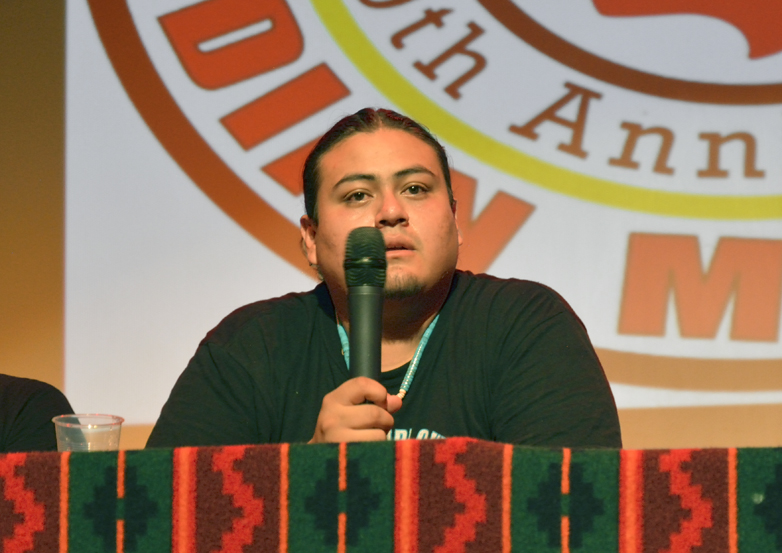 Nataanii Means, Diné (Navajo), Lakota, Omaha
Nataanii Means, Diné (Navajo), Lakota, Omaha
Voir le texte de son intervention
 Jimbo Simmons, Choctaw, de l’AIM
Jimbo Simmons, Choctaw, de l’AIM
Voir le texte de son intervention
Voir le texte de son intervention
 Félix Tiouka, Guyane “Française”
Félix Tiouka, Guyane “Française”
 Vanessa Joseph, Ka’lina, Guyane “Française”,
Vanessa Joseph, Ka’lina, Guyane “Française”,
 Nicole Chanel, Teko, Guyane “Française”
Nicole Chanel, Teko, Guyane “Française”
 Cindy Van der Pijl, Arawak/Lokono, Guyane “Française”
Cindy Van der Pijl, Arawak/Lokono, Guyane “Française”
Voir le texte des trois interventions
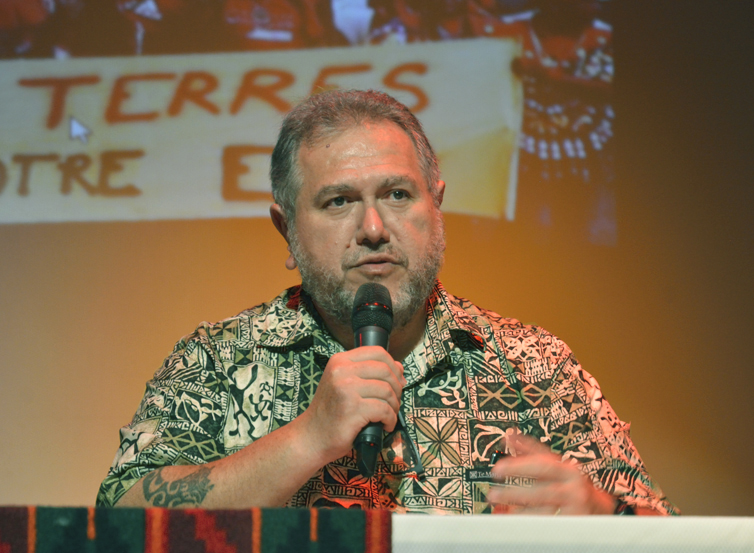 Moëtai Brotherson, député, Tahiti
Moëtai Brotherson, député, Tahiti
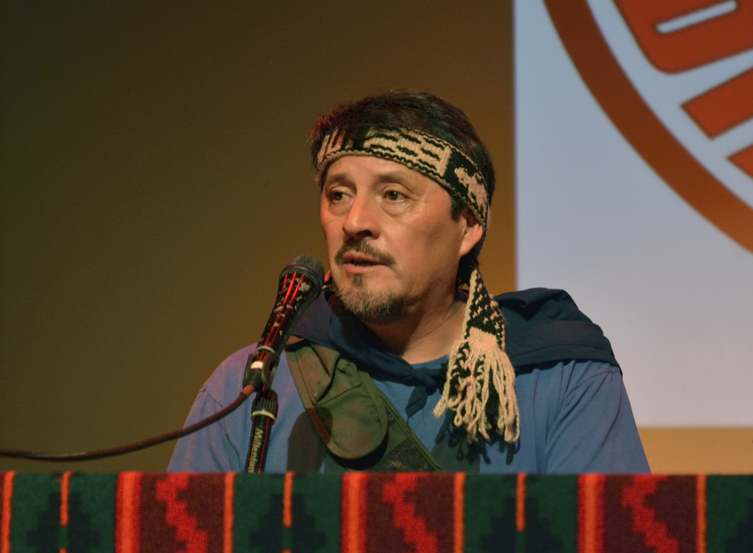 Mauro Millan, Mapuche, Argentine,
Mauro Millan, Mapuche, Argentine,
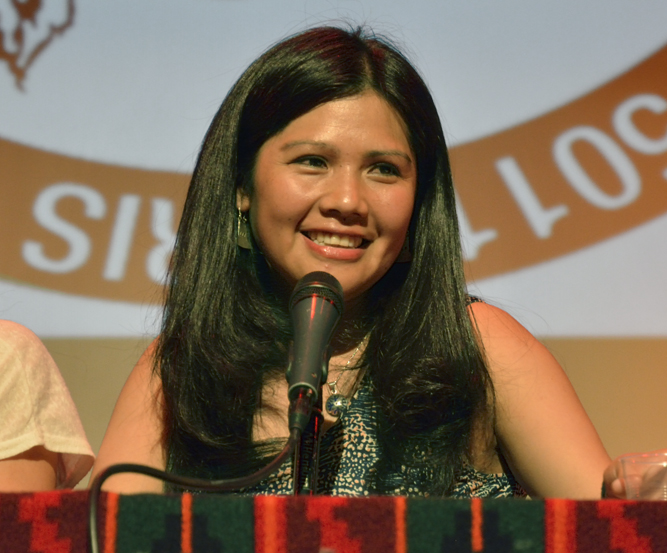 Natividad LLanquileo, Avocate Mapuche, Chili
Natividad LLanquileo, Avocate Mapuche, Chili
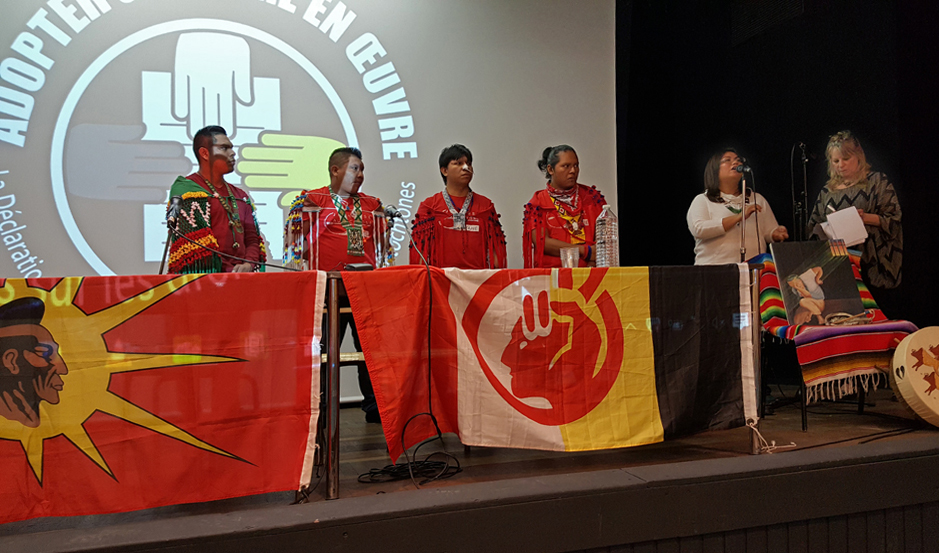 This year, for several months already, Natives of French Guiana have organized protests and strikes that ultimately forced the authorities and the media to notice them and report about them. The Indigenous Movement in French Guiana started long before, but it is only when the protests and strikes began to disturb the quiet life of settlers and authorities that they were forced to talk about it outside Guiana. Of course, the response of the French Government is totally inadequate. However, the existence of Indigenous Peoples “in France” has become visible. On October 14th, 2017, Christophe Pierre aka Yanuwana Tapoka, was among the speakers invited by the CSIA-nitassinan for their 37th Annual Day of Solidarity. You will find below my translation of Yanuwana’s speech. Before he spoke, a delegation from Natives of French Guiana came on stage to remind French people that there are “Indians in France”. The title was chosen by me, from his words, the responsibility for the choice is entirely mine.
This year, for several months already, Natives of French Guiana have organized protests and strikes that ultimately forced the authorities and the media to notice them and report about them. The Indigenous Movement in French Guiana started long before, but it is only when the protests and strikes began to disturb the quiet life of settlers and authorities that they were forced to talk about it outside Guiana. Of course, the response of the French Government is totally inadequate. However, the existence of Indigenous Peoples “in France” has become visible. On October 14th, 2017, Christophe Pierre aka Yanuwana Tapoka, was among the speakers invited by the CSIA-nitassinan for their 37th Annual Day of Solidarity. You will find below my translation of Yanuwana’s speech. Before he spoke, a delegation from Natives of French Guiana came on stage to remind French people that there are “Indians in France”. The title was chosen by me, from his words, the responsibility for the choice is entirely mine.
Christine Prat
Yanuwana Tapoka aka Christophe Pierre, Paris, October 14th 2017
Transcript and translation Christine Prat
Also published on Censored News
En Français
“Greetings to you all. My name is Christophe Pierre in the language of the colonialists, Yanuwana Tapoka in my mother tongue.
First, I think it is necessary to describe, to give a short overview, of the situation and history of French Guiana, which is currently, in legal terms, a French ‘département’ [county], a French ‘region’ like any other. What is French Guiana? French Guiana is in South America, it is a French Amazonian territory. It is 50% of the biological diversity of Europe, 80% of the biological diversity of France. It is about 300,000 inhabitants, including a handful of Native Americans who survived colonization; a handful: if we really have to give figures, it’s between ten to fifteen thousand, according to the latest information. As compared to those ten to fifteen thousand, it is nowadays estimated that, when the colonialists arrived, there were 25 to 30 Peoples, there are only six left today. Those six Peoples are the Kali’na, the Palikuyene and the Lokono, who live along the coast, and the Teko, the Wayãpi and the Wayana who live inland. Problems are different, power relationships are different depending on the geographical situation, but the struggle is practically the same, since the 1980’s.
The first gathering of Native Americans of Guiana took place in Awala, in 1984 – on December 8th and 9th, 1984. It was the first time that youths – youths at the time, now they are Elders – Native youths, spoke out against the French institution and took a political stand. This meant that a new form of struggle began for Native Americans of Guiana, a political struggle symbolized by Félix Tiouka’s speeches – I think that CSIA supported that struggle – together with Alexis Tiouka and others. They were young people who had been in the ‘Indian’ boarding schools. The Indian boarding schools meant abducting children from the families, taking children away from their parents, and put them in catholic boarding schools, where they were forced to learn the Catholic, Christian religion, from 5-years-old on, sometimes even from 3, where speaking our languages was forbidden and where, thus, a massive destruction of our traditional societies occurred. For 80 years, France ran them through the Church, and still does now… [most of those boarding schools are now closed, but at least one still exists, due to the lack of schools in some Indigenous territories].
We have a special status, in French Guiana, that makes it a territory that still has to be evangelized, as priests still get their wages from the French State. We had to face that situation, to confront a Guianese political class which did not want to hear about Native Americans, to confront France, which had almost exterminated Native Americans, physically, culturally, and in their identity. In the 1980’s, there was a youth movement mainly following leaders as Alexis Tiouka, Félix Tiouka, Thomas Appolinaire, who have been involved, in the following years, in the creation of French municipalities with Native American governance, as well as what has been called later ‘collective use rights areas’. Those collective use rights areas are the only possibility we had to try to get back some of our ancestors’ lands.
Thus, that’s where we were then, some statements were made, then the Association of Native Americans of French Guiana is created, which will include members of each Nation, of the six Nations, and will later become the Federation of Native American Organizations of Guiana (FOAG), which will lead struggles to spread information internationally. The FOAG appealed several times to the United Nations and came several times to France, to meet, for instance, President Chirac, and to take part in the campaign for recognition of those crimes that were the ‘human zoos’, in the Jardin d’Acclimatation, here in Paris. In 1994, a ceremony took place, here, at the Jardin d’Acclimatation, where, in 1858 – I think, maybe a few years later – Kali’na who had been taken from villages were exhibited in the human zoos, in the Jardin d’Acclimatation, in Paris. Most of them never returned, they died from the cold or something else, and the bodies are still held by France. The bodies had been dissected, later, experiments had been done on them. Thus, we are still trying to struggle on that issue. There has been a ceremony for the rest of their souls, once.
This is our history with France, until, approximately, the 2000’s. Then there has been sort of a dead silence, nothing was heard any more about Native Americans. The leaders of the time were getting exhausted, some of them have, I think, given up, dropped the issue, as, let’s say, the destruction of Native American identity had gone so far, that it was difficult to mobilize the people, even villagers, on issues that affected them directly. As a matter of fact, assimilation had gone so far, that we almost disappeared as a people. At the same time, illegal gold mining had begun. From the years 2000’s, the first illegal gold seekers settled in Wayana and Teko territories. With all the usual consequences, mercury poisoning, poisoning of the fish, birth defects for children… On several occasions, the Wayana tried to warn the French State, demanding for a direct solution to suppress illegal gold mining. Today, we have come to realize that illegal gold mining means that there are about 30,000 illegal gold seekers a year, Brazilian or from Guyana, present in the National Park called Amazonian Park of Guyana, and they keep polluting rivers and streams. There are 120 kilometers of waterways in French Guiana, and now, if we really look at it, there is only ONE river which is not polluted by gold mining. The Guyana Plateau, the north of Amazon, is the second largest freshwater reserve in the world, after all, and the mountain range from the south border between Guiana and Brazil to Venezuela, where the Orinoco begins, is one of the sources of the Amazon River, the largest river in the world. This is the situation with which the Wayana are confronted, and today they get very little support. On the national level, the French State puts up missions – ‘Anaconda’ was the first – and operations, but they are ineffective: some twenty military police raid an illegal site every now and then, but I think that 275 have been reported and located, this year, and there are still others which are not yet located.
Thus, this dead silence prevails, until the 2010’s, and then, there is a revival of Native American identity. This is what we always try to explain, again and again. Still, I think that we belong to the generation that has gone all the way through it. In the 1980’s, they were the first who had had some education and knew French, and understood how absurd what was proposed to us was. In the 2010’s, we were the first generation that completed college education, we had a lifestyle model very much the same as that of any western citizen. But having gone straight, all the way, we realized, first individually, as each member of the Indigenous movement, that it did not fit us. We had received a traditional education and teaching, as we did not go to the boarding schools, but we did not acquire the deepest aspects of Native American identity. And when we came to realize that, it was very violent for us. As a result, we started with the opposite process to re-appropriate our Native identity, the identity of our respective peoples. So, starting from there, realizing what is proposed to us, what is happening in the whole world, we decided to take matters in our own hands and to start doing things, but in a different way from what our Elders had done. Our elders were somehow scared, they were alone, they felt very isolated. The dialogue, the relations they had with France were different from ours. Today, we want a change, and we are ready to do anything for it. So, starting from the fact that ‘we are ready to do anything’, we began to undertake actions, and we soon realized that the French State had done its work well, that the French EMPIRE had done its work well. France is the most gifted colonial country in the world. The United States, the South American countries, are all small players, compared to France. They created ways to put peoples to sleep. Nowadays, for instance, France signed the United Nations Declaration on recognition of Indigenous Peoples. But it is only declarative. Today, it is still written in the French Constitution that Guiana is an unoccupied territory, without owner, and that when the French arrived, there were no human beings on Guiana lands. Today, if you realize what French law means, we are peoples supposed to mainly live off the forest. This is our status. And today, we realize too that, to say it lightly, the Native American struggle has become fashionable again. It is true that it feels good. And, (to come back on what Edith said earlier), that is why we said that, why we are our ancestors’ wildest dream, it is because 525 years after the end of our world, that world has disappeared. The one we had for thousands of years, that territory on which we roamed around, to which we belonged and which belonged to us. It is this relationship we had with those lands which disappeared then. Everything disappeared. At the moment when our worlds met, it was the end for us. Today, there is not much hope left over. In a few years – we reckon 20 years – in 20 years, thus, we shall be able to see if we succeeded or not. We don’t have hundreds of years ahead of us. Twenty years ago, we could say ‘it’s time to take action’, now, this time is gone. How shall I put it? We must be twice as much active, but the world you proposed, the world with which you came, is devouring itself. How did you do that? I don’t know. But to manage to convince the world that water, forests, land and air are only secondary elements, which can be destroyed in the name of development, is something I can’t find words to describe… You are Masters!
This is the healing we must achieve, that is the way we talk about it. We must purify the minds, get people to understand what is fundamental. So, here we are, a small group of young Native Americans, with still a little bit of hope, and we want to change things against the French State, which is so gifted to enslave peoples and put them to sleep. Today, there are several issues on which we have to work, about which we must fight. First is the health emergency, meaning that illegal gold seeking must be stopped at last, that what is damaged must be repaired, because it is a duty. We are aching with the Earth, we could not prevent that wound, that open wound. But at a point, it must be stopped, and then it must be healed, the Earth must be healed, water must be healed, our children must be healed. Then, there is that other mad issue, the mining project called ‘Montagne d’Or’ [‘Mountain of Gold’]. It is a Russian-Canadian project for an industrial gold mine. That project is the first of the kind in Guiana. There is currently a movement developing around the rejection of that project. But it is here, that everything is decided, it is in Paris that everything is thought of, centralization is the way France functions, so, everything is decided in Paris. But there are issues which primarily concern us, issues that will affect our children. And it is here that it is decided, in your country, our children’s future is decided in your country. This is the message that we came to bring over today. […]
This is what I wanted to tell you. […] There are practical issues on which we can fight each other, but also on which we can all work together, around which we can unite, because it’s an emergency, we have been involved in it for years now. And we are extremely angry against your country, and, at a point, to achieve a reconciliation, to contemplate forgiveness, you must, each and every one of you, admit your crimes.”
NOUVELLE VENTE SCANDALEUSE (ET ILLEGALE) A DROUOT, ET PROTESTATION DE MEMBRES D’IDLE NO MORE FRANCE ET DU CSIA-NITASSINAN
 Lundi 30 mai 2016, une nouvelle vente scandaleuse d’objets sacrés Amérindiens a eu lieu à la salle Drouot. La vente était une fois de plus organisée par la firme EVE. Quelques jours plus tôt, le Conseil Tribal Pueblo Acoma avait adressé une lettre ouverte aux Français, publiée sur Internet en anglais et en français (voir plus bas), et envoyée à des organisations de soutien. La lettre explique ce que ces objets signifient pour les Autochtones seuls autorisés à les posséder et quel sacrilège une telle vente représente.
Lundi 30 mai 2016, une nouvelle vente scandaleuse d’objets sacrés Amérindiens a eu lieu à la salle Drouot. La vente était une fois de plus organisée par la firme EVE. Quelques jours plus tôt, le Conseil Tribal Pueblo Acoma avait adressé une lettre ouverte aux Français, publiée sur Internet en anglais et en français (voir plus bas), et envoyée à des organisations de soutien. La lettre explique ce que ces objets signifient pour les Autochtones seuls autorisés à les posséder et quel sacrilège une telle vente représente.
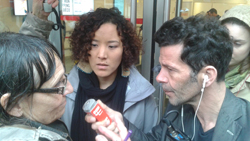 Il est évidemment nécessaire que les Français, surtout ceux qui achètent, comprennent à quel point c’est choquant et douloureux pour les Autochtones, et qu’il s’agit encore d’une violence colonialiste.
Il est évidemment nécessaire que les Français, surtout ceux qui achètent, comprennent à quel point c’est choquant et douloureux pour les Autochtones, et qu’il s’agit encore d’une violence colonialiste.
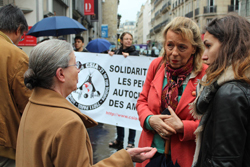 Cependant, certains ne comprendront jamais, en particulier le Tribunal du 9ème Arrondissement, où une Juge, de toute évidence croyante fanatique en la Religion Intégriste du Libéralisme Economique, a chaque fois décidé que les croyances et les sentiments devaient peut-être être respectés, mais surtout pas être une entrave à la liberté du commerce. Dans ce cas, il serait bon de faire valoir que ces objets ont forcément été achetés illégalement, vu que la vente en est interdite depuis toujours par les Autochtones auxquels ils appartiennent, et maintenant aussi par la loi américaine (le consulat des Etats-Unis a protesté, comme d’habitude). Même si le dernier acheteur dit de bonne foi avoir acheté ‘légalement’, les objets ont forcément été volés au départ, et en France comme ailleurs, il est illégal de posséder ou de vendre des objets volés. Ça s’appelle du recel, et c’est un délit. En juillet 2014, Klee Benally, Navajo de passage à Paris, accompagné de membres d’Idle No More France et du CSIA-Nitassinan (dont moi-même) a porté une lettre de protestation à la firme EVE. Monsieur le Commissaire Priseur, très agressif, après avoir essayé de prétendre que les objets avaient été achetés légalement, ce qui n’est pas possible, a fini par s’embrouiller et prétendre que les objets vendus par EVE n’étaient pas des objets sacrés, mais des objets fabriqués spécialement pour les touristes! Comme si des copies pour touristes pouvaient être vendues à 500 000 euros (un masque a été vendu pour ce prix lundi) à la Salle Drouot! En fait, cela signifie que EVE, soit vend des objets volés et est coupable de recel, soit escroque ses clients en leur vendant des faux pour touristes à un prix exhorbitant!
Cependant, certains ne comprendront jamais, en particulier le Tribunal du 9ème Arrondissement, où une Juge, de toute évidence croyante fanatique en la Religion Intégriste du Libéralisme Economique, a chaque fois décidé que les croyances et les sentiments devaient peut-être être respectés, mais surtout pas être une entrave à la liberté du commerce. Dans ce cas, il serait bon de faire valoir que ces objets ont forcément été achetés illégalement, vu que la vente en est interdite depuis toujours par les Autochtones auxquels ils appartiennent, et maintenant aussi par la loi américaine (le consulat des Etats-Unis a protesté, comme d’habitude). Même si le dernier acheteur dit de bonne foi avoir acheté ‘légalement’, les objets ont forcément été volés au départ, et en France comme ailleurs, il est illégal de posséder ou de vendre des objets volés. Ça s’appelle du recel, et c’est un délit. En juillet 2014, Klee Benally, Navajo de passage à Paris, accompagné de membres d’Idle No More France et du CSIA-Nitassinan (dont moi-même) a porté une lettre de protestation à la firme EVE. Monsieur le Commissaire Priseur, très agressif, après avoir essayé de prétendre que les objets avaient été achetés légalement, ce qui n’est pas possible, a fini par s’embrouiller et prétendre que les objets vendus par EVE n’étaient pas des objets sacrés, mais des objets fabriqués spécialement pour les touristes! Comme si des copies pour touristes pouvaient être vendues à 500 000 euros (un masque a été vendu pour ce prix lundi) à la Salle Drouot! En fait, cela signifie que EVE, soit vend des objets volés et est coupable de recel, soit escroque ses clients en leur vendant des faux pour touristes à un prix exhorbitant!
Ces ventes se sont multipliées ces dernières années (vous pouvez trouver plusieurs articles sur ce site), il semble que ce soit la mode. Il convient donc d’être vigilants et d’essayer de trouver des solutions définitives – par exemple prouver l’illégalité de ces ventes (malheureusement, je ne suis pas juriste).
Christine Prat
Photos CSIA-nitassinan et Idle No More France
************************
Lettre ouverte du Conseil Tribal Acoma aux Français (traduction fournie par eux-mêmes) Voir en anglais
Lettre ouverte au peuple de France
26 mai 2016
Le peuple du Pueblo of Acoma, une tribu indienne des Etats-Unis, appelle à l’aide le peuple de France pour qu’il lui donne son support. Une pratique très troublante (et dérangeante) existe dans les maisons de ventes aux enchères de Paris comme dans le monde de l’art et mène à l’indignation et à la condamnation dans de nombreuses tribus amérindiennes aux États-Unis, y compris le Pueblo of Acoma. Il s’agit du trafic et de la vente illégale de certains objets du patrimoine culturel de diverses tribus amérindiennes des États-Unis. Ces objets, fondamentaux pour notre culture, sont considérés sacrés et sacro-saints, et ne peuvent être ni vendus ni transférés à quiconque. Nous demandons que les maisons de ventes aux enchères françaises n’offrent pas ces articles en vente, et qu’elles assistent à les rendre à leurs propriétaires légitimes. Une telle vente aux enchères aura lieu la semaine prochaine à la Société EVE à Paris
Ces éléments ne sont pas des œuvres d’art, mais, plutôt, parties intégrantes de notre identité culturelle et de nos pratiques spirituelles. Leur perte a été terriblement douloureuse pour nous; la possibilité de leur retour nous apporte de l’ espoir. Il faut noter que le marché noir et le trafic du patrimoine culturel amérindien est illégal aux États-Unis et d’après la loi tribale du Pueblo of Acoma.
Les objets actuellement mis aux enchères sont sacrés et font partie du patrimoine culturel du peuple d’ Acoma. Ils sont d’ une grande importance – semblable aux éléments fondamentaux d’églises, de basiliques et de lieux de culte dans le monde entier. Ces objets sont si importants que personne ne peut les détenir, les vendre ou les transférer. Ils sont vénérés et utilisés dans la prière et les cérémonies par les chefs traditionnels de nos Pueblo – cérémonies sacrées célébrées pour le bénéfice du monde entier. Malheureusement, dans la dernière décennie, ces articles ont été enlevées de nos terres traditionnelles et ont fini dans des ventes aux enchères, sur l’internet et dans les galeries d’art aux Etats-Unis et, plus récemment, en Europe. Ces lieux de ventes ont créé une incitation monétaire pour les voleurs et les malfaiteurs.
Pour ceux en Europe qui ne connaissent pas notre histoire, nous vous proposons ce bref résumé. L’histoire archéologique du peuple Pueblo a ses origines dans l’état du Nouveau- Mexique il y a plus de 10.000 ans. Cependant, le peuple Pueblo croit avoir occupé cette terre depuis des temps immémoriaux. Bien qu’il n’y ait pas de trace écrite reflétant la présence de la population Pueblo, de nombreuses preuves existent sous forme de marques, gravures rupestres, toutes images qui reflètent notre vision du monde, ainsi que de grandes structures monumentales, habitations, kivas et objets qui parlent de civilisations existant bien avant l’arrivée des premiers Européens.
Au fil des siècles, le peuple du Pueblo s’est déplacé et s’est installé dans une zone connue sous le nom de Four Corners dans la partie sud-ouest des États-Unis. Là, il a construit de grandes structures communales dans des lieux comme Chaco Canyon et Mesa Verde. Autour de l’an 1300, le peuple ancestral d’Acoma s’est déplacé de la région de Four Corners à “un lieu préparé” dans l’ouest du Nouveau-Mexique. Il y a établi un grand pueblo qui a été continuellement habité depuis. Des siècles plus tard, le peuple d’Acoma continue de maintenir sa culture, son style de vie, et son système de croyance distinct fondé sur une forte connexion à la terre et à des repères géographiques importants, en combinaison avec leurs coutumes sociales, leur affiliations claniques et leur cérémonies sacrées et vénérées. Le Pueblo reste sur ses terres d’origine, sa structure de gouvernance, sa langue, sa culture, ses cérémonies, son système de croyance toujours intacte, et ses familles et sa communauté protégée par les lois laïques et traditionnelles du Pueblo.
Nous vous demandons d’ aligner vos convictions avec les nôtres et de faire appel aux maisons d’enchères de Paris afin qu’elles arrêtent la pratique de la vente des objets identifiés sacrés par le Pueblo, actions qui sont clairement fausses et profanes.

